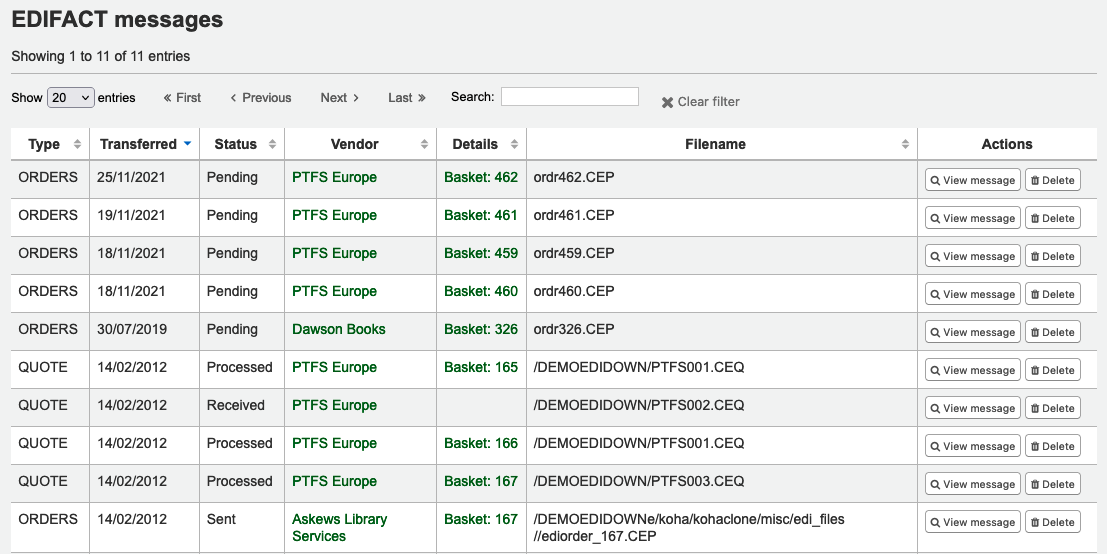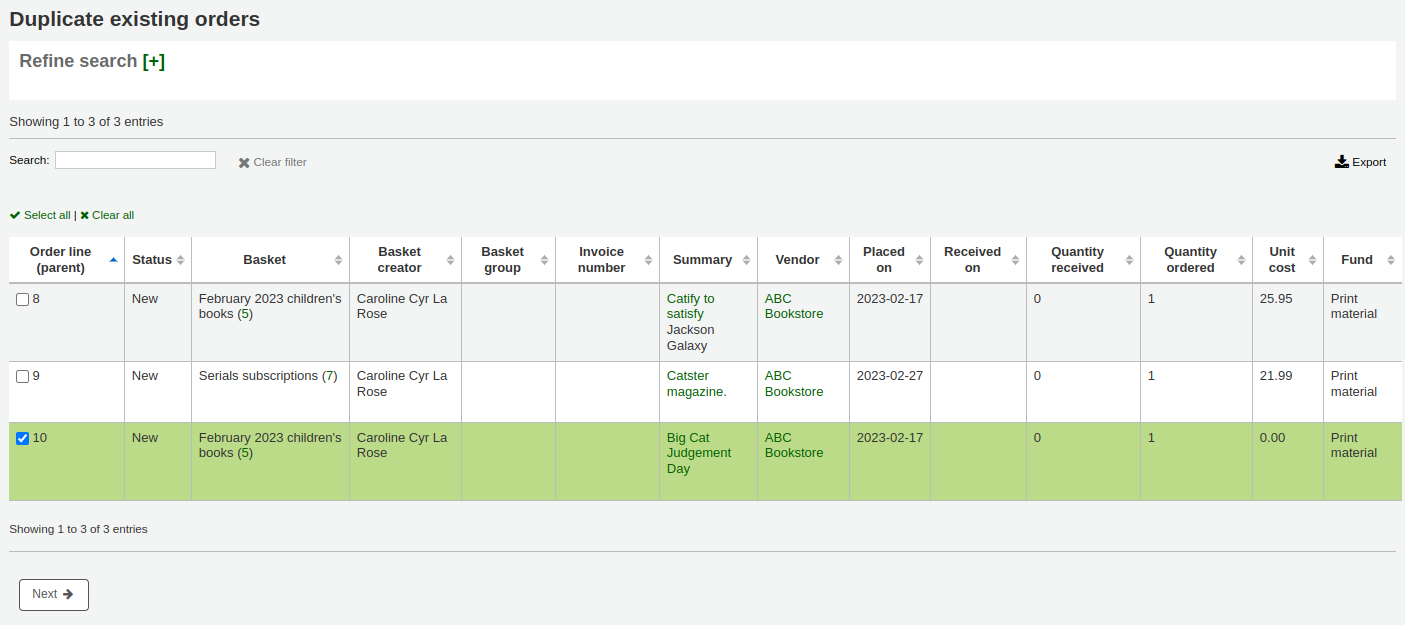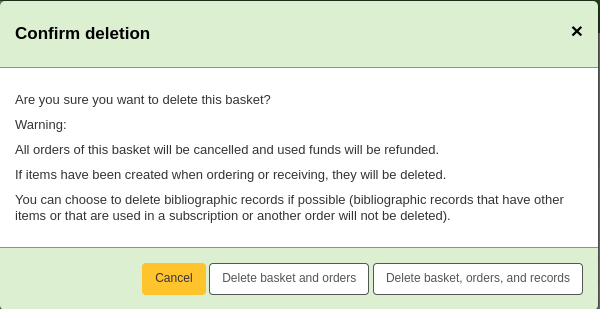Adquisiciones
Koha’s acquisitions module provides a way for the library to record orders placed with vendors and manage purchase budgets.
Ir a: Más > Adquisiciones
Setting up the acquisitions module
Before using the acquisitions module, you need to make sure that you have completed all of the set up.
En primer lugar, configurar las :ref: “preferencias de sistema de adquisiciones <acquisitions-system-preferences-label> y el módulo de administración de adquisiciones para que se ajusten al flujo de trabajo de su biblioteca. Antes de configurar sus cuentas EDI y el EAN de la biblioteca necesitará haber ingresado sus proveedores.
En la página principal de adquisiciones verá la relación de las partidas presupuestarias de su biblioteca.

Aprenda más en la sección :ref:`Presupuesto/seguimiento de fondo<budget-fund-tracking-label>” de este manual.
Proveedores
Antes de ingresar cualquier pedido deberá ingresar primero al menos un proveedor.
Adding a vendor
To add a vendor click the “New vendor” button on the acquisitions module main page.

The new vendor form is broken into three sections: company information, contacts and ordering information.
Company information: basic information about the vendor

Name (required): this name is the name that will appear everywhere in Koha when referring to this vendor
Postal address, physical address, phone, fax, website, account number: these fields are optional and should be filled to help with generating claim letters and invoices
Vendor type: use this field as needed to categorize your vendors (for example, bookseller, donor, electronic resource provider)
Nota
By default, this field is a free text field. If you’d rather have a drop-down menu, add values in the VENDOR_TYPE authorized value category.
Aliases: add one or more aliases to a vendor as additional keywords to search with in the vendor search. For example, the vendor “American Library Association” could have the alias “ALA”.
Contacts: information regarding your contact(s) at the vendor’s office
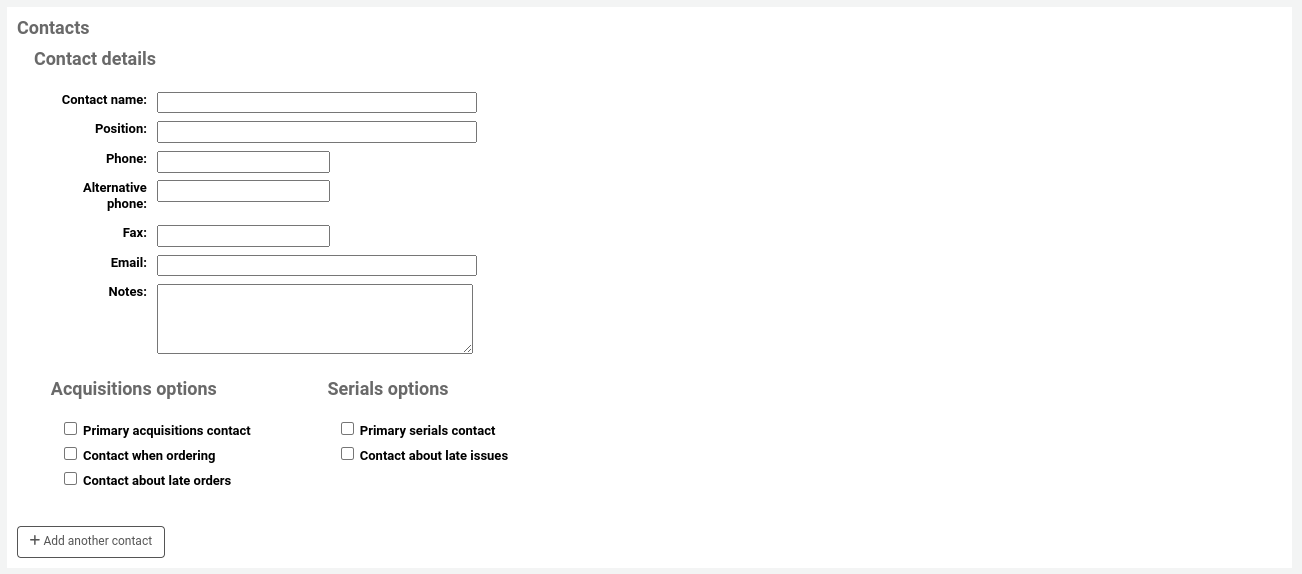
Ninguno de estos campos son obligatorios, debería introducirse únicamente si usted quiere llevar un registro de la información de contacto dentro de Koha
Contacto primario de acquisicion: compruebe esta caja si esta persona es su contacto primario en referencia a la adquisicion de este vendedor
Contacto primario de series: compruebe esta caja si esta persona es su contacto primario en referencia a la adquisicion de este vendedor
¿Contactar cuando se ordena? Compruebe esta caja si desea mandar sus órdenes por correo electrónico directamente a esta persona (ver la sección de cestas de edición a continuación)
¿Contactar acerca de pedidos atrasados? Compruebe esta caja si desea mandar sus reclamaciones de adquisiciones por correo electrónico directamente a esta persona
¿Contactar acerca de ediciones atrasadas? Compruebe esta caja si desea mandar sus reclamos en serie por correo electrónico directamente a esta persona
Usted puede agregar mas de un contacto por proveedor haciendo clic en el botón “Agregar otro contacto”
Interfaces: information regarding the vendor’s website, software, or portal that you use to manage orders or gather statistics from this vendor or organization. Entering an interface is not required, use this section only to keep track of the information within Koha. To add a vendor interface, click on “Add another interface”.

Fill out the form (all fields are optional):
Name: enter the name of the interface, this will be visible in Koha.
Type: choose the interface type.
Nota
Values in this drop-down menu are managed in the VENDOR_INTERFACE_TYPE authorized value category.
URI: enter the interface’s URL address.
Login: enter the username for the vendor interface.
Password: enter the password for the vendor interface.
Nota
The password entered here will be encrypted in the database. It will not be shown by default in the vendor details page, there will be a “Show” link in place of the password which can be clicked to display the password.
Account email: enter the email used for the account on this interface.
Notes: enter any notes regarding this interface.
Click “Add another interface” if you need to add more than one interface for this vendor.
Ordering information: general billing information

Para poder hacer un pedido a un proveedor éste debe estar “Activo”
Choose the currency for list prices and invoice prices
Nota
Currencies are set up in the Currencies and exchange rates administration section
If your library is charged tax, mark your tax number as registered
Note if your list prices and invoice prices include tax
Introduzca la tasa del impuesto si a su biblioteca le cargan impuestos a los pedidos
Nota
Tax rates are set in the TaxRates system preferences
Si el proveedor ofrece un descuento, introduzca el procentaje en el campo “Descuento”
Nota
Usted pueda introducir descuentos específicos del ítem al hacer un pedido
Si usted sabe cuánto tiempo suelen tardar en llegar los pedidos de este proveedor puede introducir un tiempo de entrega. Esto le permitirá a Koha estimar cuando llegarán los pedidos a su biblioteca en el informe de pedidos atrasados.
Las notas son para uso interno
Searching for vendors
Search for vendors either from the search bar at the top of the page

Or in the “Manage orders” box on the main acquisitions page.

You can search for any part of the vendor’s name, or their aliases.
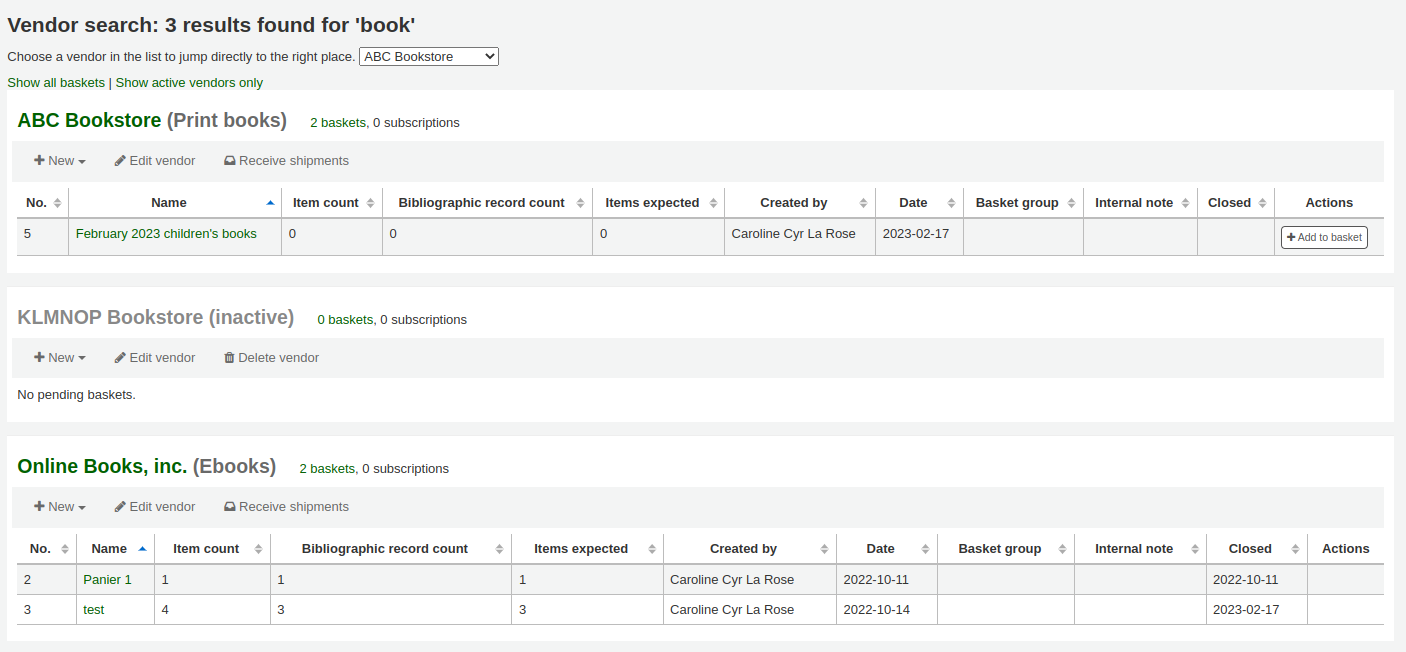
Nota
An empty search will return all vendors.
If you have a lot of vendors, you can use the dropdown menu to jump directly to a result.
By default, all vendors appear in the results, with inactive vendors in gray font and an “(inactive)” note next to their name. You can click on “Show active vendors only” to hide inactive vendors.
In the results, you can see all the currently open baskets. You can click on “Show all baskets” to show closed baskets as well.
There are action buttons under each vendor:
“New” can be used to create a new basket, or add a new contract to that vendor.
“Edit vendor” is used to edit the vendor information.
“Receive shipments” will appear when a vendor has baskets with orders.
“Delete vendor” will appear when a vendor has no baskets.
Viewing a vendor
Para ver la página de información de un proveedor tiene que buscar al proveedor desde la página principal de Adquisiciones. La búsqueda se puede hacer con cualquier parte del nombre del proveedor:

From the results, click on the name of the vendor you want to view.
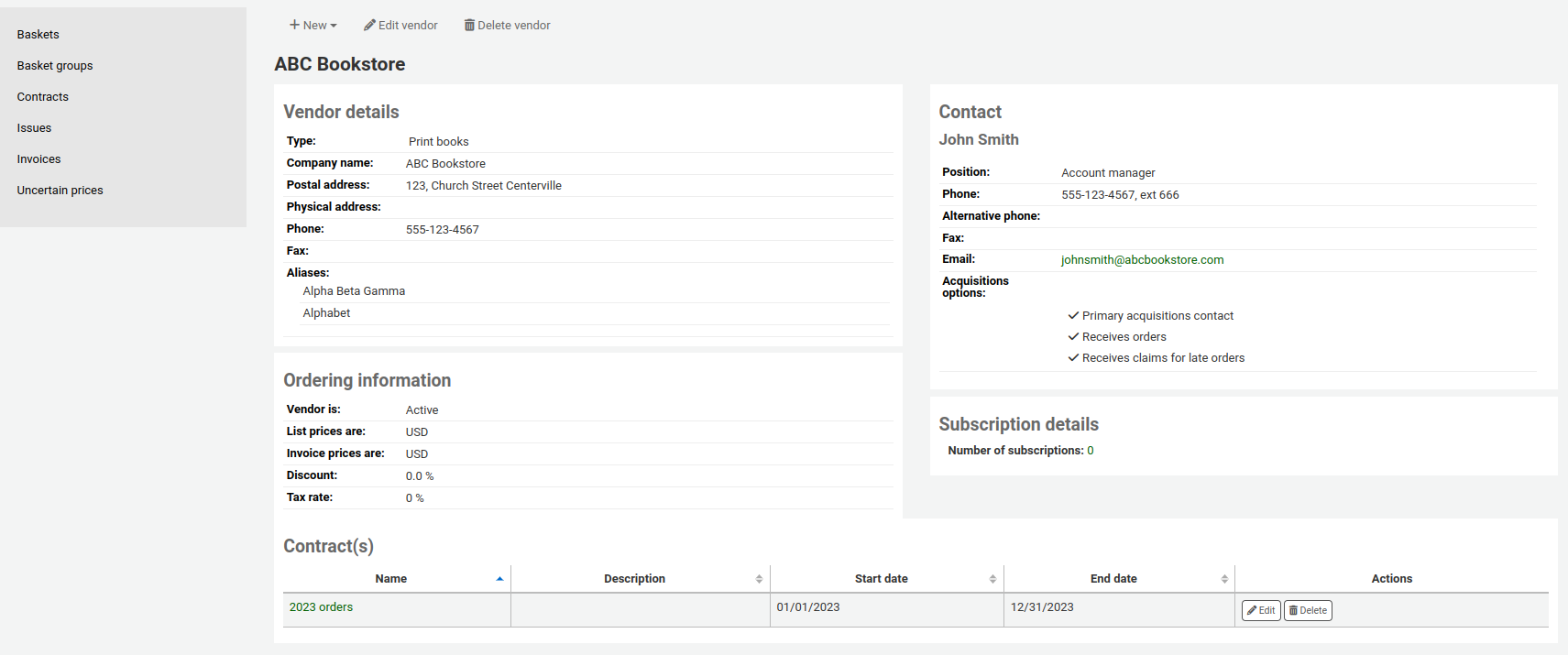
Editing vendor information
To make changes to a vendor search for the vendor from the acquisitions home page.
Click the “Edit vendor” button on the results page

or on the vendor information page.

Contratos de proveedor
Puede definir contratos (con fecha de inicio y fin) y asociarlos a un proveedor. Esto es usado para que al final del año pueda ver cuanto gastó en un contrato específico con un proveedor. En algunos lugares, los contratos se configuran con un mínimo o máxima cantidad anual.
Adding a contract
You can add a contract to a vendor by searching for the vendor, clicking the “New” button and choosing the “Contract” option.

Alternatively, you can access the vendor page and click “New” and choose “Contract” from there.
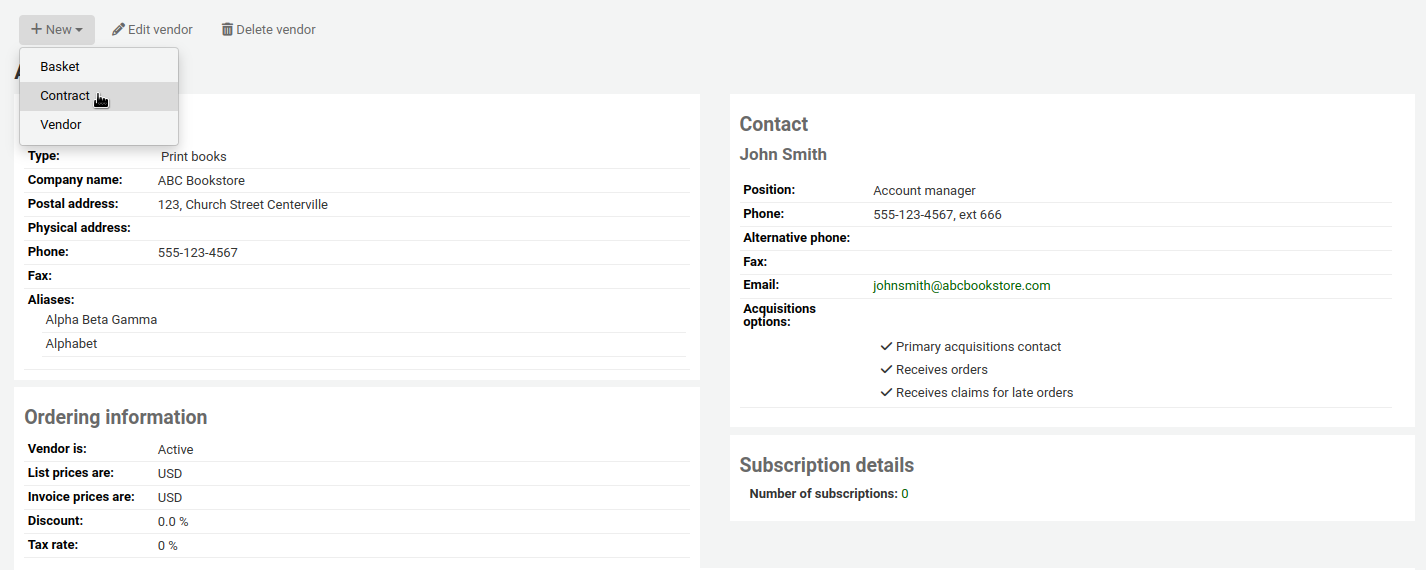
El formulario de contrato le pedirá cierta información muy básica sobre el contrato

Advertencia
Importante: Usted no será capaz de entrar en un contrato de forma retrospectiva, la fecha de finalización no debe ser antes de la fecha de hoy.
Una vez que el contrato se guarda aparecerá debajo de la información del proveedor.

Habrá también una opción cuando se crea una cesta
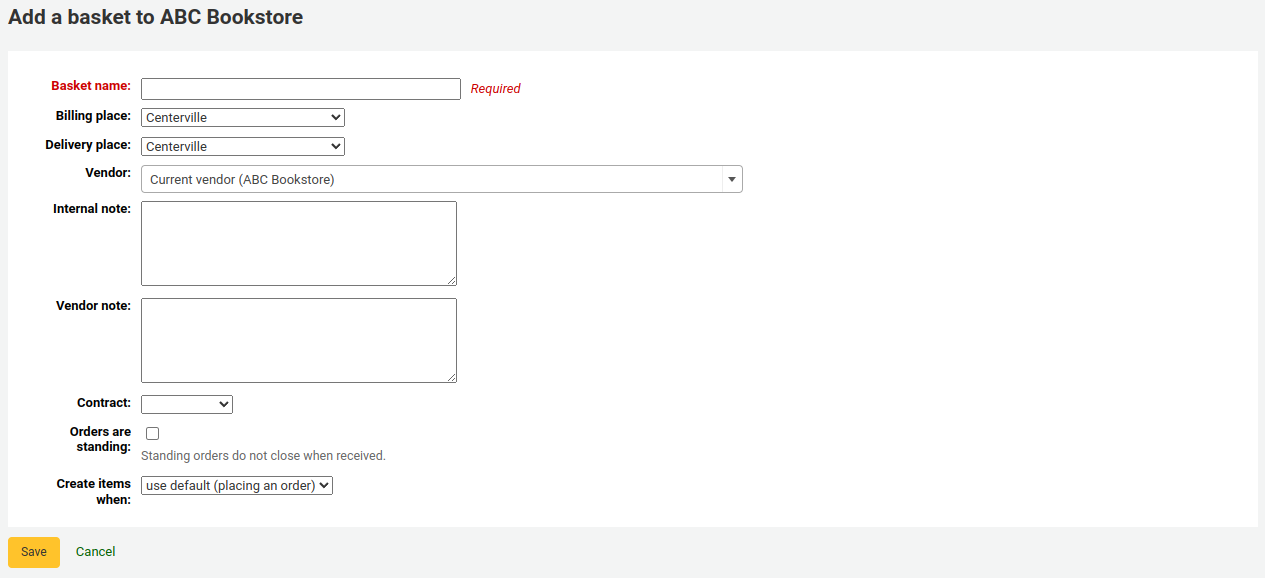
Recording issues with vendors
Version
This feature was introduced in version 23.11 of Koha.
Vendor issues are a way to keep track of problems that might arise with vendors. This helps when comes the time to renegotiate contracts.
To access vendor issues, go to the vendor’s page and click on “Issues” from the menu on the left side.

This page will show all the issues that have been recorded for this vendor.

To record a new issue,
Click “New issue”
Fill out the form with the issue information.

Type: choose the type of issue.
Nota
Values in this drop-down menu are managed in the VENDOR_ISSUE_TYPE authorized value category.
Started on: choose the date on which the issue started.
Ended on: choose the date on which the issue ended, if that is the case.
Notes: enter details about the issue.
Click “Submit”.
To edit an existing issue, click the “Edit” button in the table.
If an issue is no longer relevant, you can delete it by clicking the “Delete” button in the table.
Gestionar sugerencias de compra
You can create purchase suggestions via the staff interface either for the library or on the patron’s behalf from their record. Depending on your settings in the suggestion system preference, patrons may also be able to make purchase suggestions via the OPAC.
Nota
Debe iniciar sesión como miembro del personal con suggestions_manage acquisitions permission para ver y trabajar con sugerencias de compra.
If you have the suggestions_manage permission but not Acquisitions permissions you can access the suggestion management tool from Suggestions under the More menu in the header bar.
When a suggestion is waiting for library review, it will appear on the Acquisitions home page next to the vendor search. The suggestions for the branch where you are logged in will be separated from the rest of the suggestions. Clicking the library name will take you to the suggestion management tool.

It will also appear on the main staff dashboard under the module labels.

If there are no pending suggestions you can access the suggestion management tool by going to the “More” menu and choosing “Suggestions” or by clicking the “Manage suggestions” link on the menu on the left of the Acquisitions module home page.

Nota
Puede personalizar las columnas de esta tabla en la sección “Configuración de columnas” del módulo de Administración (id de tabla: suggestions).
Your suggestions will be sorted into several tabs: Pending, Accepted, Checked, Ordered and Rejected.
Pending: A “Pending” suggestion is one that is awaiting action from the library.
Accepted: An “Accepted” suggestion is one that you have marked as “Accepted” using the form below the suggestions.
Checked: A “Checked” suggestion is one that has been marked as “Checked” using the form below the suggestions.
Ordered: An “Ordered” suggestion is one that has been ordered using the From a purchase suggestion link in an order basket.
Rejected: A “Rejected” suggestion is one that you have marked as “Rejected” using the form below the list of suggestions.
Nota
If your workflow requires more statuses for suggestion management, you can add more using the SUGGEST_STATUS authorized values category.
Each suggestion will show the name of the staff member who managed the suggestion as well as the date when it was managed.
Accepted and rejected suggestions will show the reason for accepting or rejecting it under “Status”.
For libraries with a lot of suggestions, there are filters on the left hand side of the Manage Suggestions page to assist in limiting the number of titles displayed on the screen.
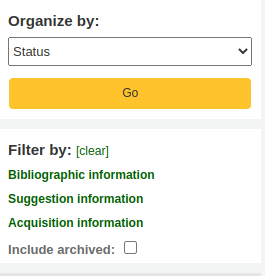
Haciendo clic en los encabezados azules expandirá las opciones de filtrado y haciendo clic en “[limpiar]” eliminará los filtros y mostrará todas la sugerencias.
Nota
The suggestions page will automatically be limited to suggestions for your library. To see information for all (or any other) libraries change the library in the “Viewing suggestions for library” dropdown menu.
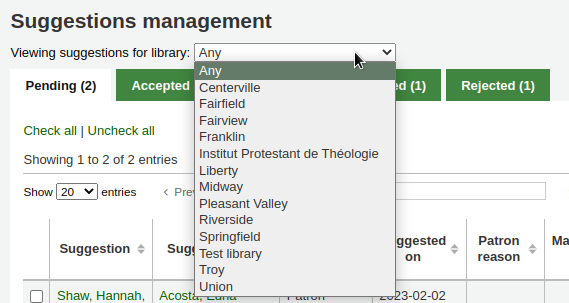
Approving or rejecting purchase suggestions
When changing the status of a purchase suggestion (pending, accepted, rejected, checked, or ordered), the suggestion will be moved to the matching tab. The status will also be updated on the patron’s account in the OPAC and an email notice will be sent to the patron using the template that matches the status you have chosen.
When reviewing “Pending” suggestions check the boxes next to the purchase suggestions you want to approve or reject and then choose the status and reason for your selection in the “Change selected suggestions” section below.
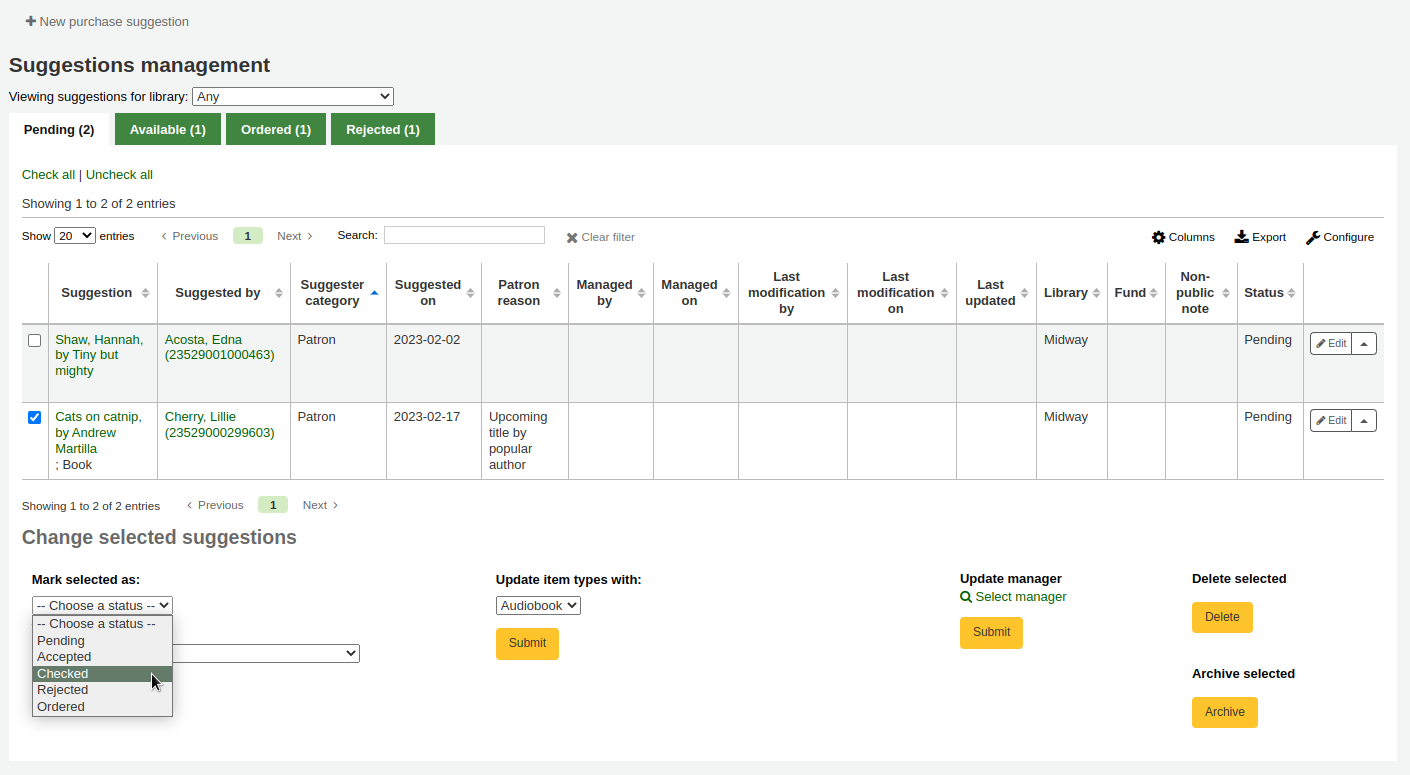
Nota
If your workflow requires more statuses for suggestion management, you can add more using the SUGGEST_STATUS authorized values category.
Reasons for accepting and rejecting suggestions are defined by the SUGGEST authorized value category.
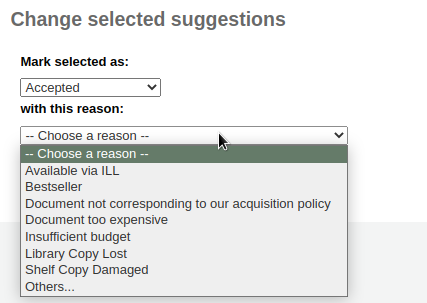
If you choose “Others…” as your reason, you will be prompted to enter your reason in a text box. Clicking “Cancel” to the right of the box will bring back the pull down menu with authorized reasons.
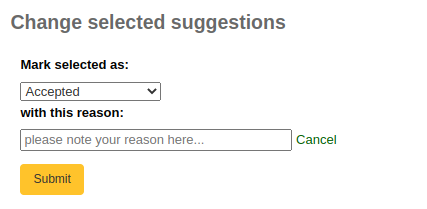
It is also possible to approve or reject suggestions one by one by clicking on the title of the suggestion to open a summary of the suggestion.
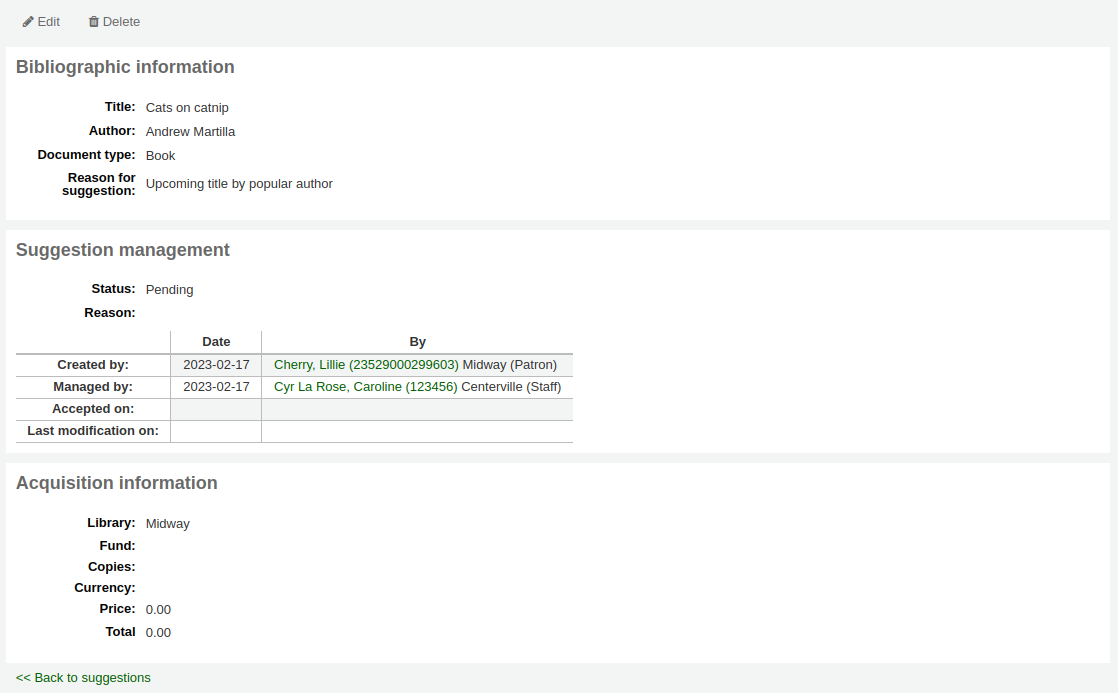
Click “edit” at the top of the suggestion detail page to open the suggestion editing page.
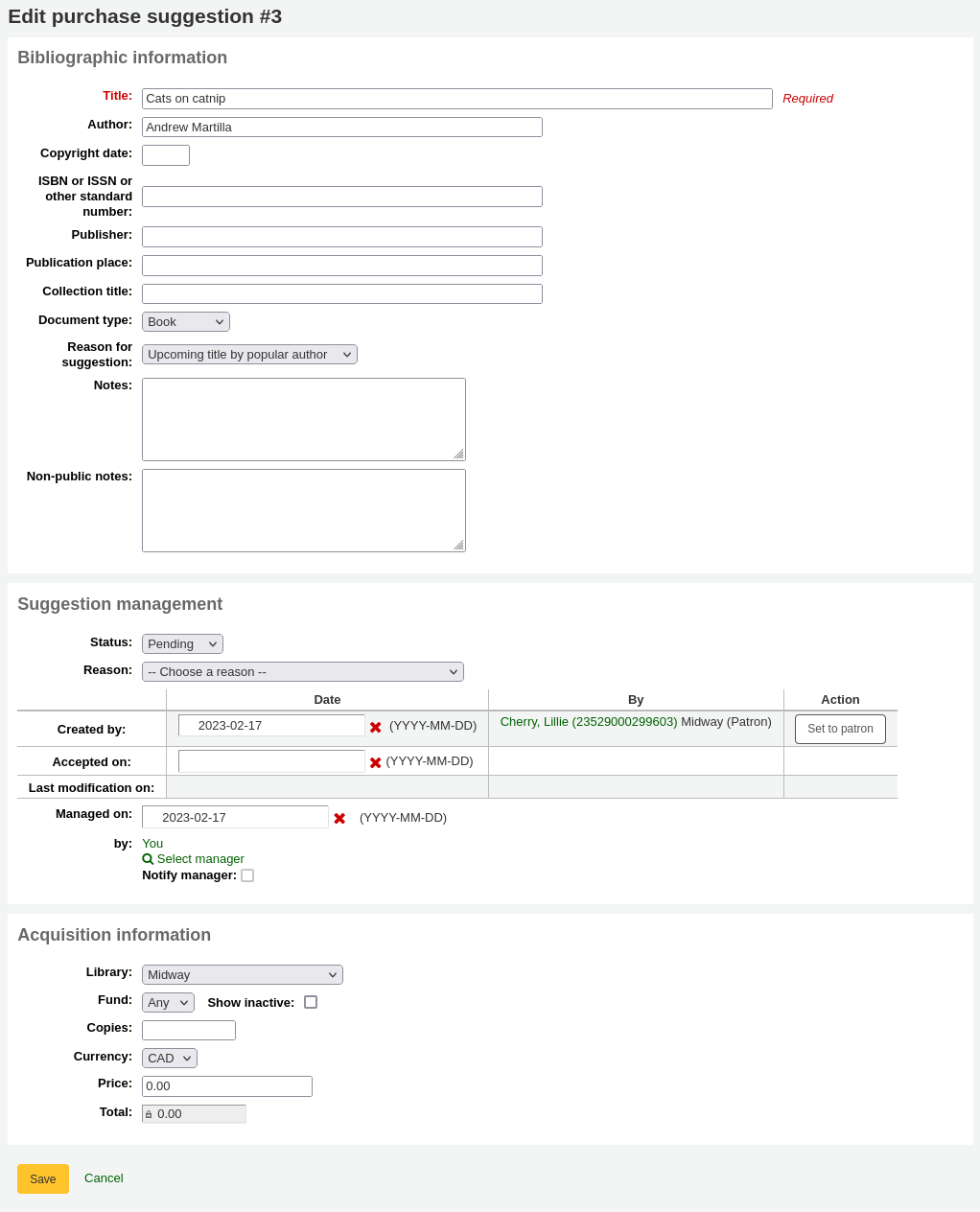
From there, change the status in the “Suggestion management” section and click “Save”.
A suggestion’s status change will trigger a notice to be sent to the patron who made the suggestion. The notices can be edited in the Notices and slips tool.
The “Accepted” status will trigger the ACCEPTED notice
The “Rejected” status will trigger the REJECTED notice
The “Ordered” status will trigger the ORDERED notice
Nota
The “Ordered” status will automatically be set when ordering from a suggestion and the corresponding notice will also be sent at that time.
Change to this status manually only if you don’t use the acquisitions module to enter your orders.
Nota
If you add custom statuses in the SUGGEST_STATUS authorized values, you can add corresponding notices with the same names, taking care to choose the “Suggestions” module when creating the new notices.
Editing purchase suggestions
Other than changing the status to accept or reject the purchase suggestions, you can also change various attributes while managing the suggestions.
Edits can be done in a batch by selecting the suggestions and choosing the new values in the “Change selected suggestions” section at the bottom of the page.
You can change the item type of the suggestions by selecting them and choosing the new item type in the “Update item types with” drop down menu.
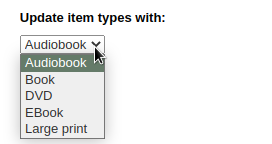
Nota
The item types in this list are populated by the SUGGEST_FORMAT authorized value category.
You can also change the manager of the selected suggestions by clicking the “Select manager” link and searching your user database. The new manager will receive the NOTIFY_MANAGER notice.
Nota
Only users who have the “superlibrarian” or the “suggestions_manage” permission will show in the results.
It is also possible to edit suggestions one by one by clicking on the “Edit” button to the right of the suggestion or by clicking on the title of the suggestion.

Clicking “edit” at the top of the suggestion detail page will open a suggestion editing page.

Desde este formulario puede editar las sugerencias (agregando más detalles o actualizando información incorrecta provista por el usuario). También puede aceptar o rechazar la sugerencia individualmente.
In the “Bibliographic information” section, you can add missing information, such as the ISBN, publisher, etc. or correct wrong information provided by the patron.
This information will be used to create a bibliographic record should you order this title from the suggestion.
In the “Suggestion management” section, you can edit the status, add a reason for accepting or rejecting the suggestion, or adjust the dates if needed.
Choosing to mark a suggestion as “Pending” will move it back to the “Pending” tab.
The “Notify manager” checkbox can be used to send a notice to the staff member who previously managed the suggestion to inform them the suggestion was modified. The notice sent is NOTIFY_MANAGER notice.
In the “Acquisitions information” section, you can edit the fund, price, currency, etc.
Assigning the suggestion to a fund will trigger a notice to be sent to the fund owner to inform them that there is a suggestion ready for them to manage.
The notice_unprocessed_suggestions.pl cronjob is necessary to generate these notices.
The notice used is TO_PROCESS, it can be edited in the Notices & slips tool.
Archiving purchase suggestions
Once the suggestion has completed the acquisitions process, it is possible to archive them. If you have a lot of suggestions, and the page takes a long time to load, archiving old suggestions will improve the performance.
Select the suggestions you want to archive and click the “Archive” button in the “Archive selected” box.
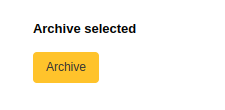
You can also archive the purchase suggestion by clicking the small arrow next to the “Edit” button and choosing “Archive”.

Archived suggestions will disappear from the list, but they can be viewed by checking the “Include archived” checkbox in the filters.

Archived suggestions will have a the mention “Archived” under the title information when they are viewed.

Nota
Archived suggestions will disappear from the “Your purchase suggestions” section of the patron’s file on the OPAC.
Deleting purchase suggestions
Once you no longer need the purchase suggestions, you can completely delete them from the system.
To delete purchase suggestions in batch, select the suggestions you want to delete completely and click the “Delete” button in the the “Delete selected” box.
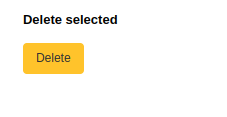
You can also delete a purchase suggestion by clicking the small arrow next to the “Edit” button and choosing “Delete”.

It is also possible to delete purchase suggestions by clicking on the title of the suggestion to access the suggestion detail page and clicking the “Delete” button from there.

Old purchase suggestions can be automatically deleted using the purge_suggestions.pl cronjob.
Haciendo pedidos
To place an order you must first search for the vendor or bookseller and create a basket.
Advertencia
If you are planning on using EDIFACT to submit your order you will need to first set up your library’s EDI accounts and EANs.
Creating a basket
Nota
Si esta usando EDI para pedidos debera bajar su registro de pedido de sus proveedores antes de empezar el proceso en Koha.
To create a basket you must first search for the vendor you’re ordering from. From the vendor search results, click the “New” button and choose “Basket”.

Alternatively, you can click on the vendor’s name to access the vendor page and click “New” and choose “Basket” from there.
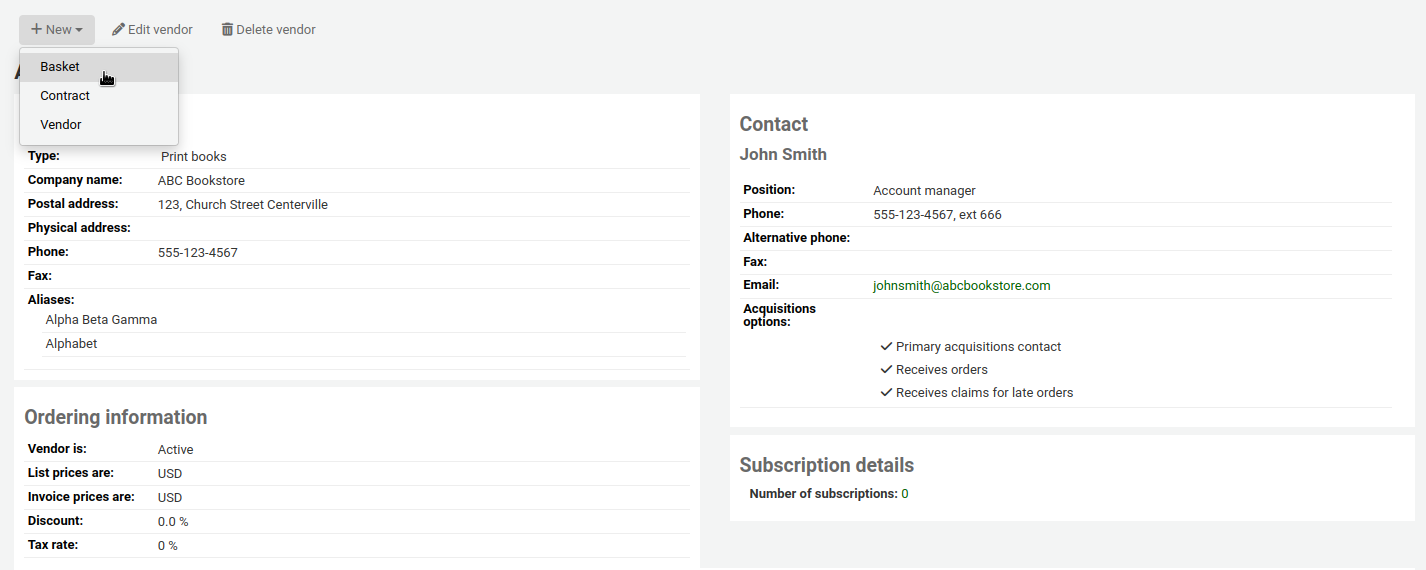
After clicking “New” and “Basket” you will be asked to enter some information about the order basket:

Give the basket a name that will help you identify it later
Ingrese el Lugar de facturación y el Lugar de envío (esto se predetermina a la biblioteca en la que ha ingresado)
Si desea cambiar el proveedor al cual está ordenando puede utilizar el menú desplegable Proveedor
Los campos de notas son opcionales y pueden contener cualquier tipo de información.
If you have added contracts to the vendor you’re ordering from, you will have an option to choose which contract you’re ordering these items under.
If you’re ordering standing items (items which arrive regularly), check the “Orders are standing” box for this basket.
Note that one basket cannot contain both firm and standing orders.
Puede elegir crear items al generar el pedido, al recibir el pedido, o al catalogar el ejemplar. Si elige una opción que no sea la predeterminada, sólo aplicara a esta cesta. El comportamiento predeterminado se establece usando la preferencia de sistema :ref:”AcqCreateItem <acqcreateitem-label>”.
If you have additional fields for order baskets, they will appear here.

Cuando haya finalizado, haga clic en “Guardar”.

Adding materials to the basket
Once your basket is created, click on “Add to basket” from the basket page.

To add to an existing basket click “Add to basket” to the right of an existing basket.

Several options for adding items to the order will be presented.
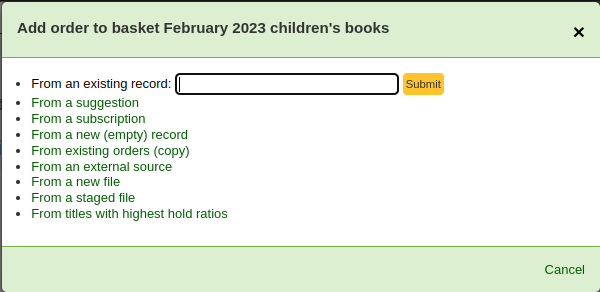
Pedido desde un registro existente
Si está pidiendo otra copia de un ítem existente, puede simplemente buscar el registro en su sistema.
Desde los resultados, haga clic en “Agregar pedido” para ir al formulario de pedido.

Desde la vista de detalles de registro, haga click en el botón “Agregar pedido”

Usted será llevado al formulario de pedido
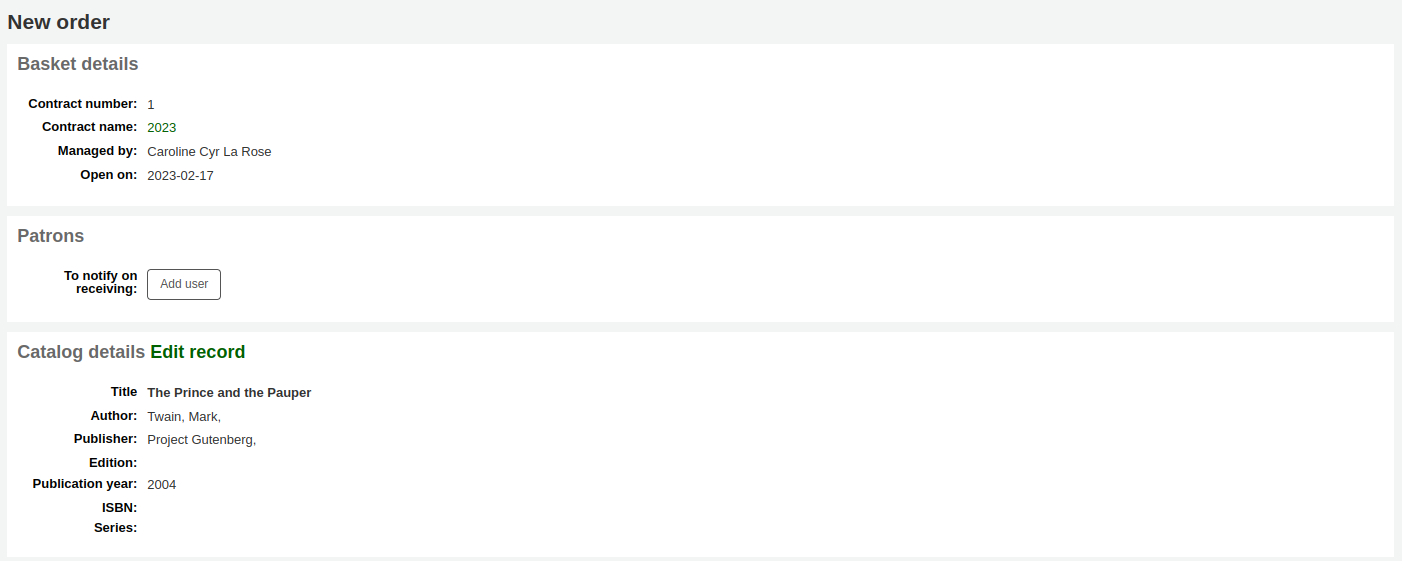
Todos los detalles asociados con el ítem se listarán bajo “Detalles de catalogación.”
Fill out the rest of the order form, including patron notifications, items, and accounting details.
Pedido desde una sugerencia de compra
If you allow patrons to make purchase suggestions (learn more in the managing purchase suggestions section of this manual), you can place orders from those suggestions. In order to keep track of suggestions that have been ordered and received you must place the order using this link.
Advertencia
Las sugerencias deben ser aceptadas para poder pedirlas.

De los resultados, haga clic en “Hacer pedido” junto al ítem que desea pedir y se irá al formulario de pedido incluyendo el enlace a la sugerencia
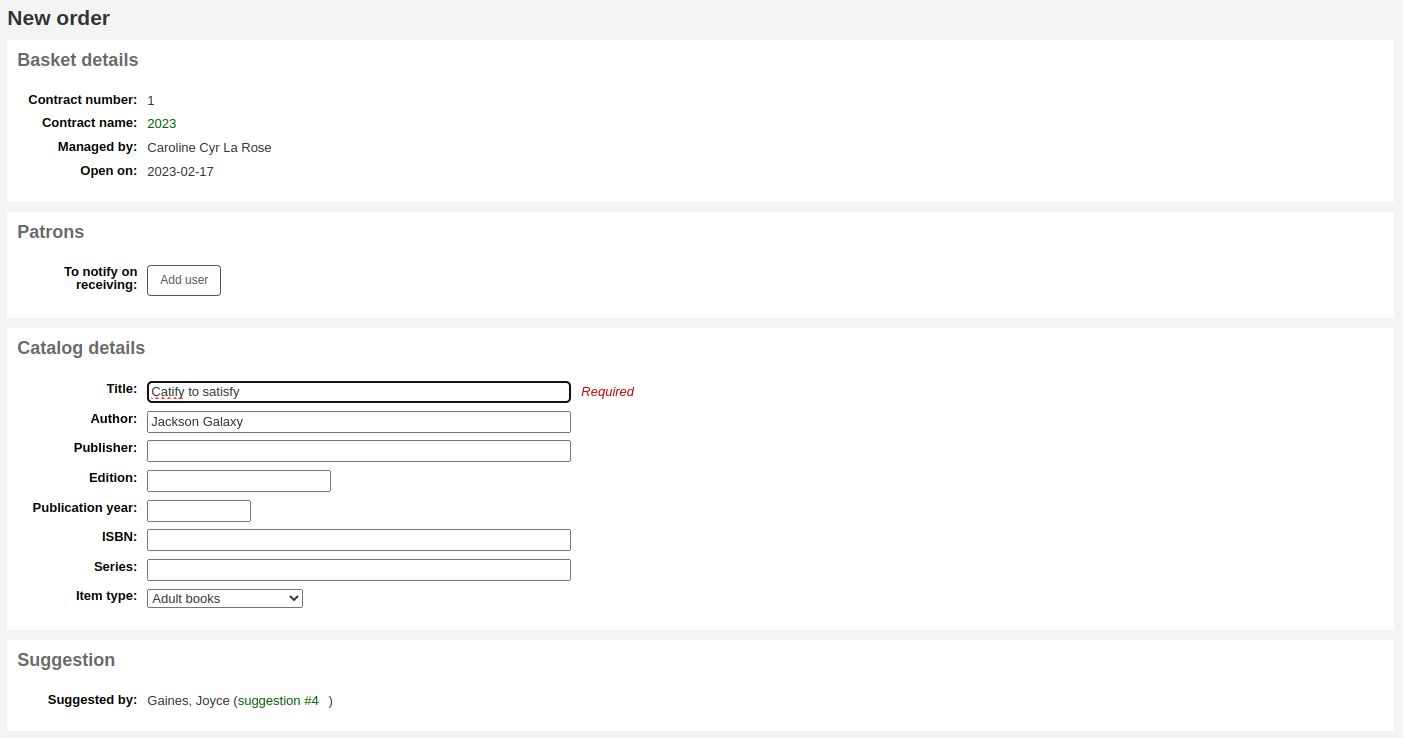
Desde este formulario puede hacer cambios a los detalles del catálogo si es necesario.
Cuando el ejemplar aparezca en su cesta incluirá un enlace a la sugerencia.

Orders added to the basket in this way will notify the patron via email that their suggestion has been ordered (with the “ORDERED” notice in Tools > Notices and slips) and will update the patron’s “your purchase suggestions” page in the OPAC.
Agregar pedido desde una suscripción
If you are using the Serials module you can link your subscription order information to acquisitions by choosing to order “From a subscription”.
Después de dar clic en en enlace del pedido usted será llevado a la página de búsqueda, de modo que, le ayudará a encontrar su suscripción

Sus resultados aparecerán a la derecha del formulario y cada suscripción tendrán un enlace de “Pedido” a la derecha

Clicking “Order” will bring the subscription info in to the order form without an “Add item” section since you are just ordering a subscription and an item is not needed
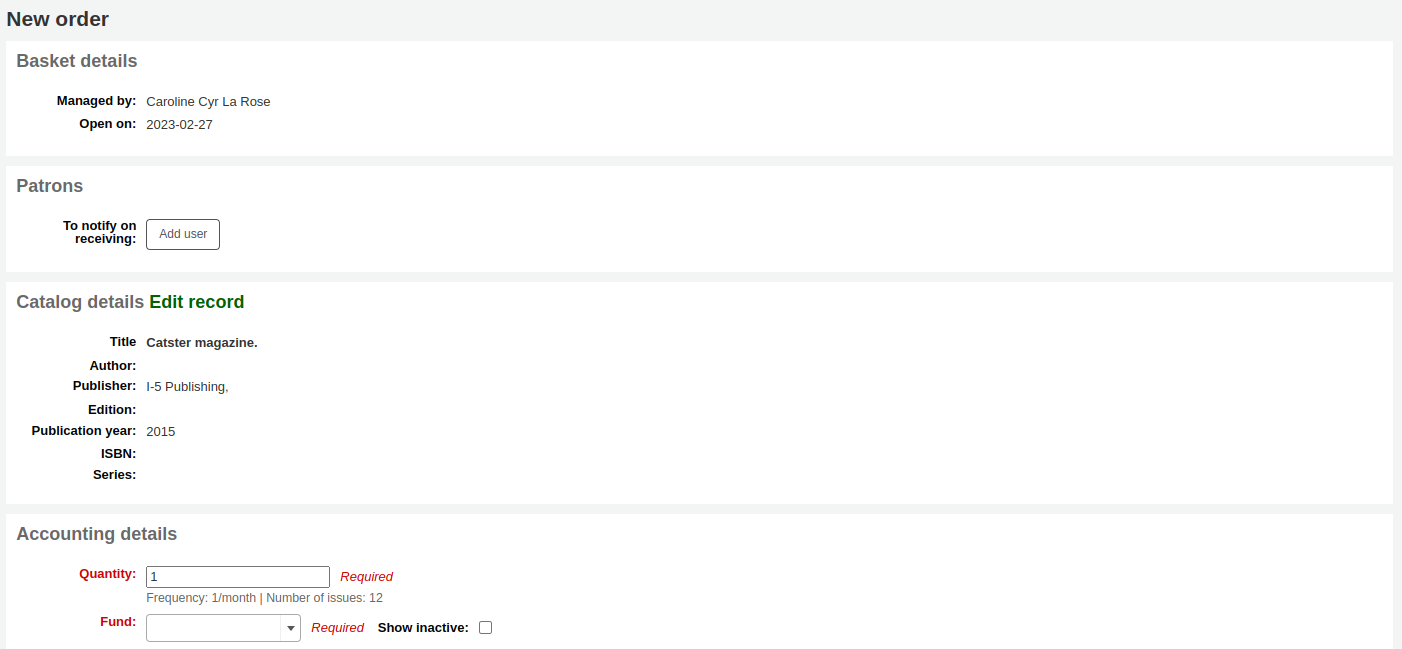
Pedido desde un nuevo registro (vacío)
Para hacer un pedido de un registro que no se puede encontrar en ningún otro lugar, elija la opción “Desde un nuevo registro (vacío)”.
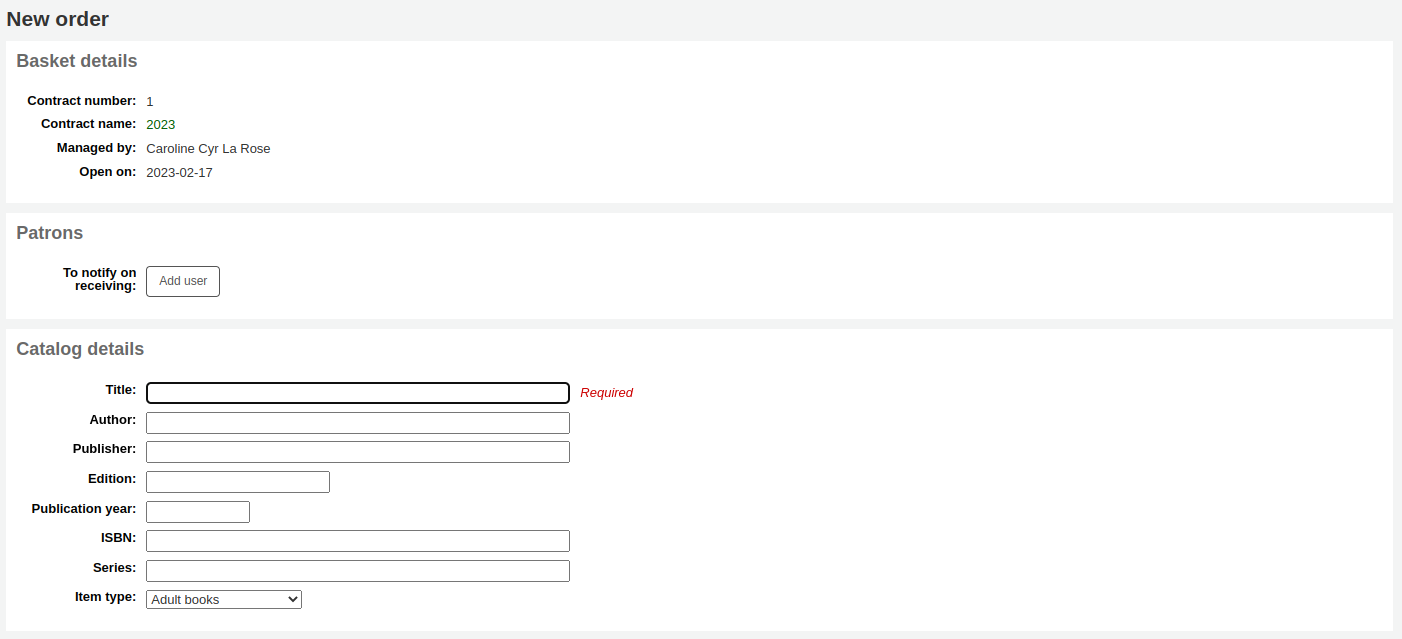
Se le presentará con un formulario en blanco para rellenar con todos los datos necesarios sobre el ítem que está pidiendo.
Nota
If the default form does not have the necessary bibliographic fields to place an order, enable the UseACQFrameworkForBiblioRecords preference which will allow the ACQ MARC framework to customize the display of fields when ordering.
Duplicar pedidos (hacer pedidos a partir de pedidos existentes)
Puede duplicar un pedido existente eligiendo la opción “Desde un pedido existente (copiar)”.
Se le presentará un formulario de búsqueda para buscar sus pedidos existentes.
Haga clic en las cajas al lado de cada pedido que desee duplicar.
Click “Next”
Check the boxes next to the values to copy from the original order or choose new values.
Click “Duplicate orders”
Click “Return to the basket”
Pedido desde una fuente externa
You can search other library catalogs for the record of an item to purchase using the “From an external source” option. This will allow you to order from a MARC record found via a Z39.50 search.

From the results, click anywhere in the row of the title you want to add to your basket and choose the “Order” option.

Si el ejemplar que usted está pidiendo de una fuente externa parece ser un duplicado, Koha le advertirá y le dará opciones sobre cómo proceder.

Use existing record: order another copy on the existing bibliographic record
Cancel and return to order: cancel the order
Create new record: create a new bibliographic record, while keeping the existing one also
Pedido desde un archivo nuevo
Si su proveedor le envió un archivo de registros (un archivo .mrc por ejemplo), puede agregar pedidos usando los registros contenidos en ese archivo. Elija la opción “Desde un archivo nuevo”.
Nota
Note that you need the stage_marc_import tool permission in order to be able order from a new file.
Usted será llevado a la herramienta Preparar registros MARC para la importación. Prepare sus archivos como se describe en esa sección
Una vez que sus archivos se preparen, usted puede hacer clic en el botón “Agregar archivos preparados a la cesta”.
Next to each title is a checkbox, check the items you would like to order, or choose “Select all” at the top. Depending on your settings in the MarcFieldsToOrder system preference, Koha will populate the next screen with with the relevant quantity, price, fund, statistic 1, and statistic 2 found within the staged file.
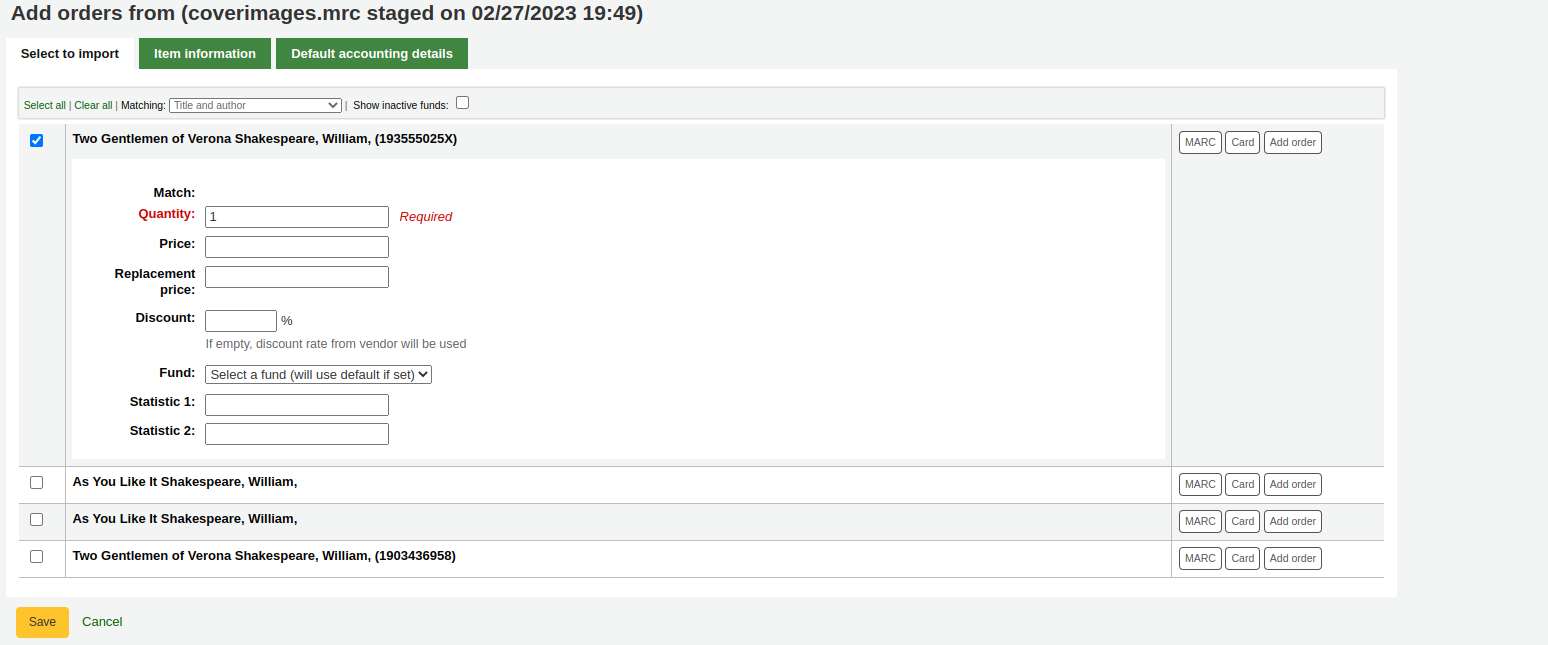
En la pestaña “Información del ejemplar” puede introducir información que se agregará a cada ejemplar pedido tal como el tipo de ejemplar, código de colección y el estado de no para préstamo.
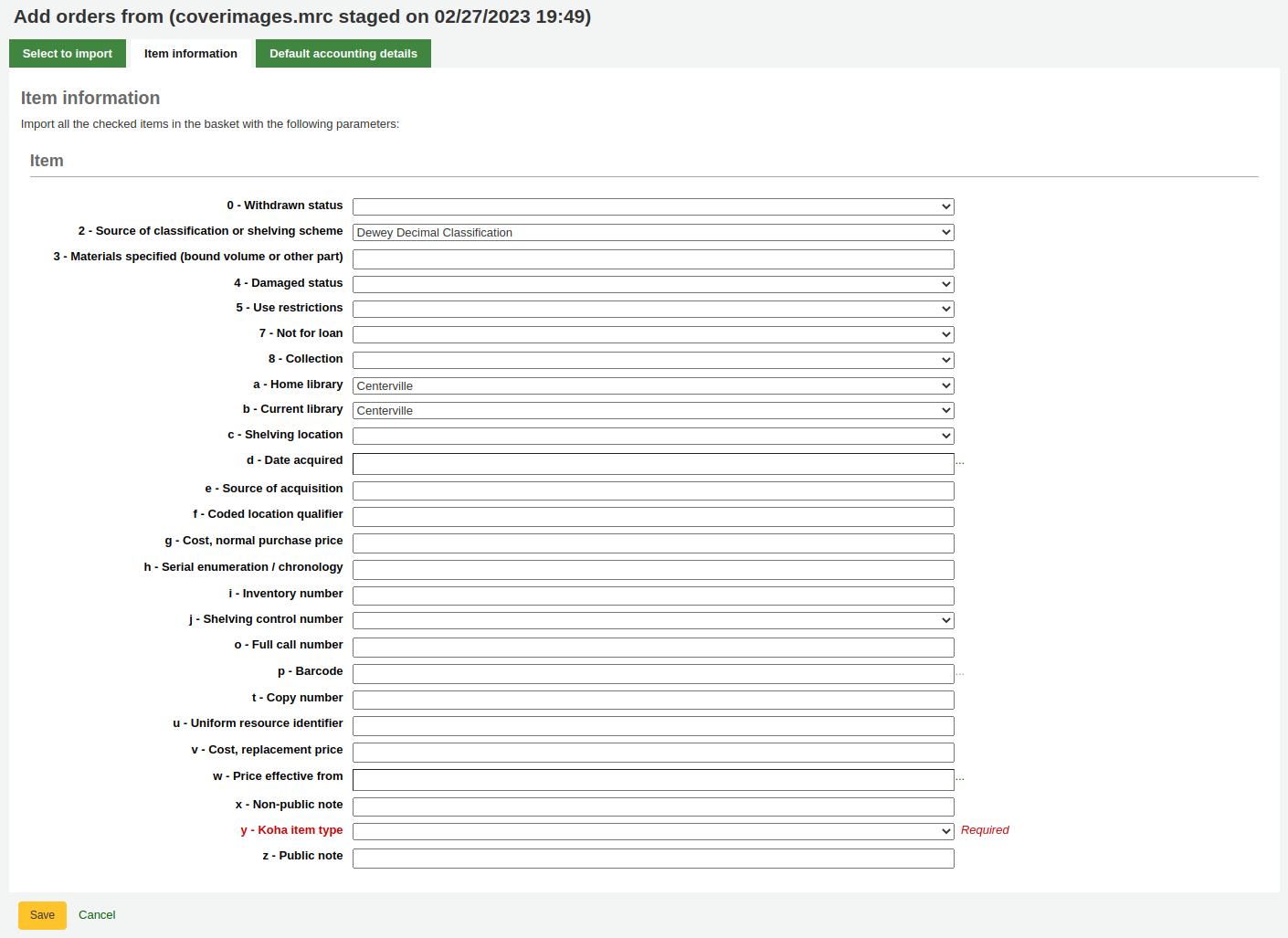
If no information is imported in the fund information from the MARC with the MarcFieldsToOrder system preference, the “Default accounting details” tab can be used to apply values related to the accounting.
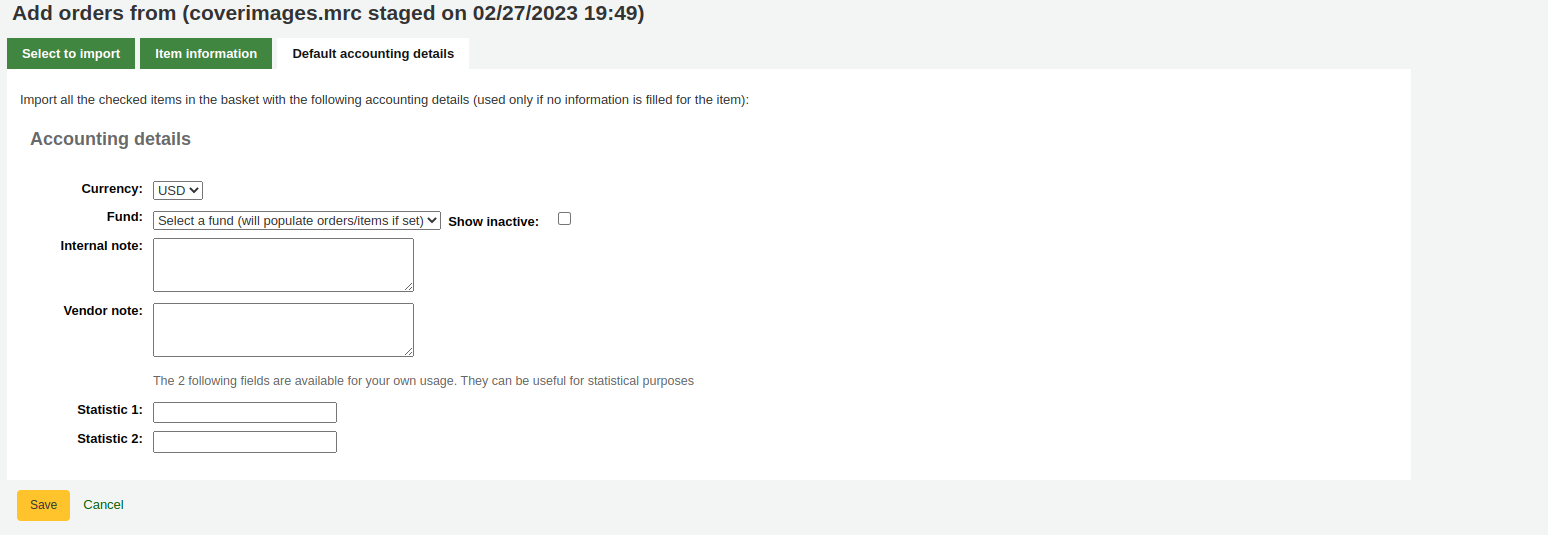
Click “Save” to add to the basket
Pedido desde un archivo preparado
Esta opción es la misma como la previa, pero en este caso, su archivo ya ha sido :ref:”preparada<stage-marc-records-for import-label>”. Si usted escoge el “pedido de un nuevo archivo” o “pedido de un archivo preparado” dependera en la acquisicion del flujo de trabajo en su :ref:”permisos<patron-permissions-label>”.
Una vez que haga clic en “Desde un archivo preparado”, obtendra una lista de todos los archivos preparados en su sistema.

Desde el listado de archivos se le presentara con, haga clic en el botón “Agregar pedidos” para agregar los registros del archivo preparado a su pedido.
Next to each title is a checkbox, check the items you would like to order, or choose “Select all” at the top. Depending on your settings in the MarcFieldsToOrder system preference, Koha will populate the next screen with with the relevant quantity, price, fund, statistic 1, and statistic 2 found within the staged file.

En la pestaña “Información del ejemplar” puede introducir información que se agregará a cada ejemplar pedido tal como el tipo de ejemplar, código de colección y el estado de no para préstamo.

If no information is imported in the fund information from the MARC with the MarcFieldsToOrder system preference, the “Default accounting details” tab can be used to apply values related to the accounting.

Click “Save” to add to the basket
Pedido de títulos con más altos índices de reservas
The final option for ordering is to order from a list of titles with the highest hold ratios.
Esta opción lo llevará al informe de proporción de reservas donde puede encontrar ejemplares con una alta proporción de reserva y para pedir copias adicionales. Al lado de cada título habrá un botón con el número de ejemplares para pedir, haga clic ahi y se agregará el ejemplar a su cesta.

Setting up patron notifications
With any of the above ordering options you’re presented with an option to notify patrons of the new item when it’s received. The contents of that notification can be edited in the Notices and slips tool and will have the code of ACQ_NOTIF_ON_RECEIV. In the “Patrons” section you will see an option to “Add user”. Click that button to add patrons who will be notified of the new issue.
Cambios de los usuarios
En la ventana que aparece busque los usuarios que desea notificar y haga clic en “Agregar”
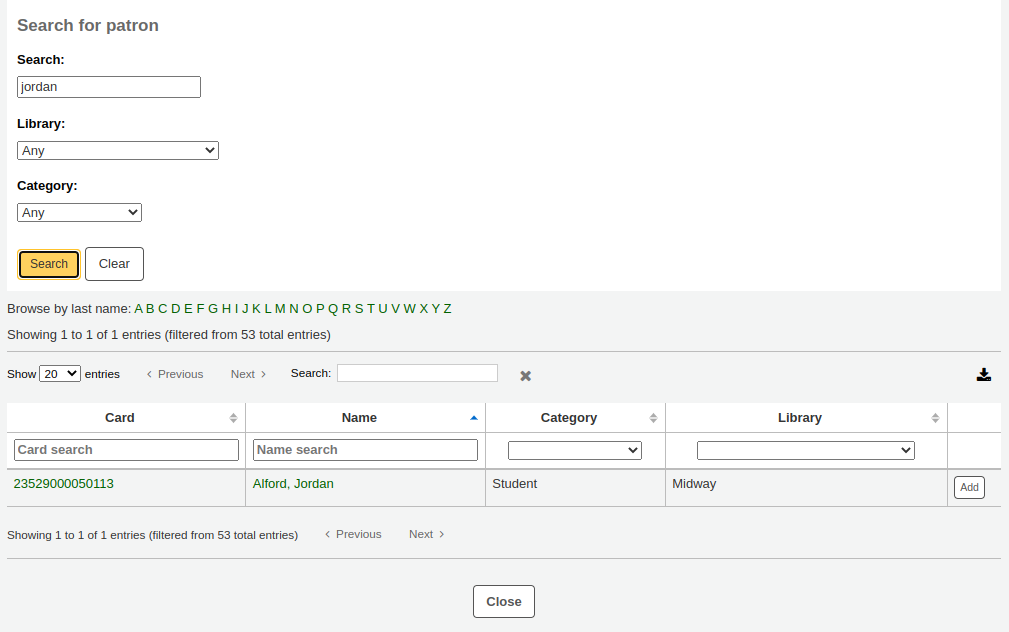
Una vez que hayas terminado puedes cerrar la ventana y podrás ver la lista de usuarios en la sección “Usuarios”

Adding items to orders
After bringing in the record information (for all order methods except for the staged files), if your AcqCreateItem system preference is set to add an item when ordering you will enter the item information next. You need to fill out at least one item record and then click the “Add item” button at the bottom left of the item form.
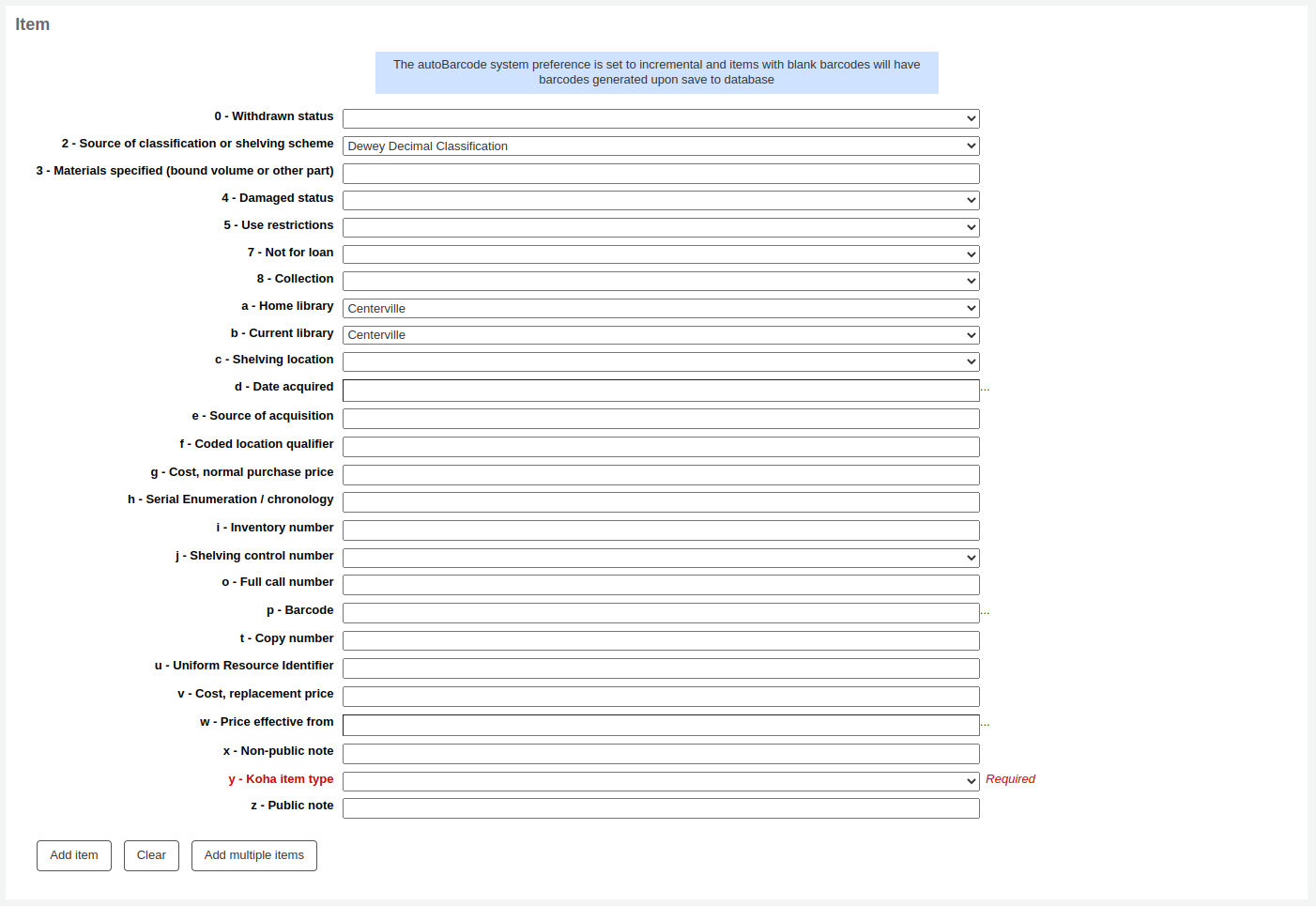
Luego de hacer clic en agregar el ítem aparecerá encima del formulario y, entonces, podrá ingresar su siguiente ítem de la misma forma (si pidió más de uno).

Si esta ordenando varios ejemplares, puede hacer clic en “Agregar ejemplares multiples” en vez de agregarlos uno por uno. Esto le preguntará cuantos ejemplares quiere agregar. Simplemente ponga el número en la casilla de comprobación y haga clic en “Agregar”.

Adding accounting details to orders
Una vez que haya ingresado la información sobre el ítem, es necesario ingresar la información contable.

Quantity: enter the quantity of copies you want to order.
Advertencia
If the item is created upon ordering, you will not be able to edit the quantity manually, you must add items to the order by clicking “Add item” below the item form to add as many items as you’re ordering.
Fund: choose the fund that will be used to buy this title.
The list of funds is populated by the funds you have created in the Acquisitions administration area.
If you have a lot of funds, you can start to type the fund name in the field and the list will be filtered for you.
By default, only funds for active budgets will be available in the drop-down menu. If you need to also see your inactive funds, check the “Show inactive” box.
Currency: choose the currency of the price.
El desplegable de monedas tendrá las monedas que configuró en el área de Administración de adquisiciones.
Vendor price: enter the price before any taxes or discounts are applied.
Uncertain price: if the price is uncertain, check the uncertain price box. You will be able to go back later to enter the right price.
Nota
A basket with at least one uncertain price cannot be closed.
See the section Dealing with uncertain prices below to learn how to manage uncertain prices.
Tax rate: if you are charged sales tax, choose the rate.
This field is populated by the TaxRates system preference.
Discount: enter the percentage discount you’re receiving on this order. Once you enter this, hit tab and Koha will populate the rest of the cost fields below.
Retail price: enter the recommended retail price (RRP), the price set by the publisher or the manufacturer as a recommendation to booksellers.
Replacement cost: enter the cost to replace the item. This is the price charged to the user when an item is declared lost (if the WhenLostChargeReplacementFee system preference is set to “Charge”).
El costo de presupuesto es la cantidad que será eliminada del presupuesto “gastado”. si este número incluye o excluye los impuestos dependerá en la “Lista de precios” configurado en su :ref:”proveedor<vendors-label>”.
El Total es el costo del presupuesto multiplicado por la cantidad de ejemplares pedidos.
Actual cost: this field is usually left empty until receiving, when you can confirm the actual cost against the vendor’s packing slip or invoice.
Internal note: this will only appear in the acquisitions module and in the staff interface catalog, under the “Acquisitions details” tab in the detailed record.
Vendor note: this will appear in the acquisitions module as well as on the order when exported as CSV.
Estimated delivery date: you can specify an estimated delivery date for this specific order. If no date is entered here, the estimated delivery date will be calculated according to the “Delivery time” in the vendor information. This date is used when managing late orders
If you added statistical categories when creating the fund, those values will appear in the two statistics fields.
If you have additional fields for order lines, they will appear here.
Una vez que haya llenado todos los campos haga clic en “Guardar” para agregar el ejemplar a su cesta. Si su precio sube arriba de la cantidad disponible en el fondo se le presentara una confirmación.

El aviso de confirmación le permitie ordenar aunque se pase de la cantidad de fondo si lo desea.
Once your order is entered you can search for it through acquisitions or view the information on the bibliographic record detail page in the staff interface, if the AcquisitionDetails system preference is set to “Display”, or view the information on the bibliographic record detail page in the OPAC, if the OPACAcquisitionDetails system preference is set to “Display”.

Nota
You can customize the columns of this table in the “Table settings” section of the Administration module (table id: acquisitiondetails-table).
Editing the basket
Una vez que un ítem se agrega a la cesta se le presentará un resumen de la bolsa.
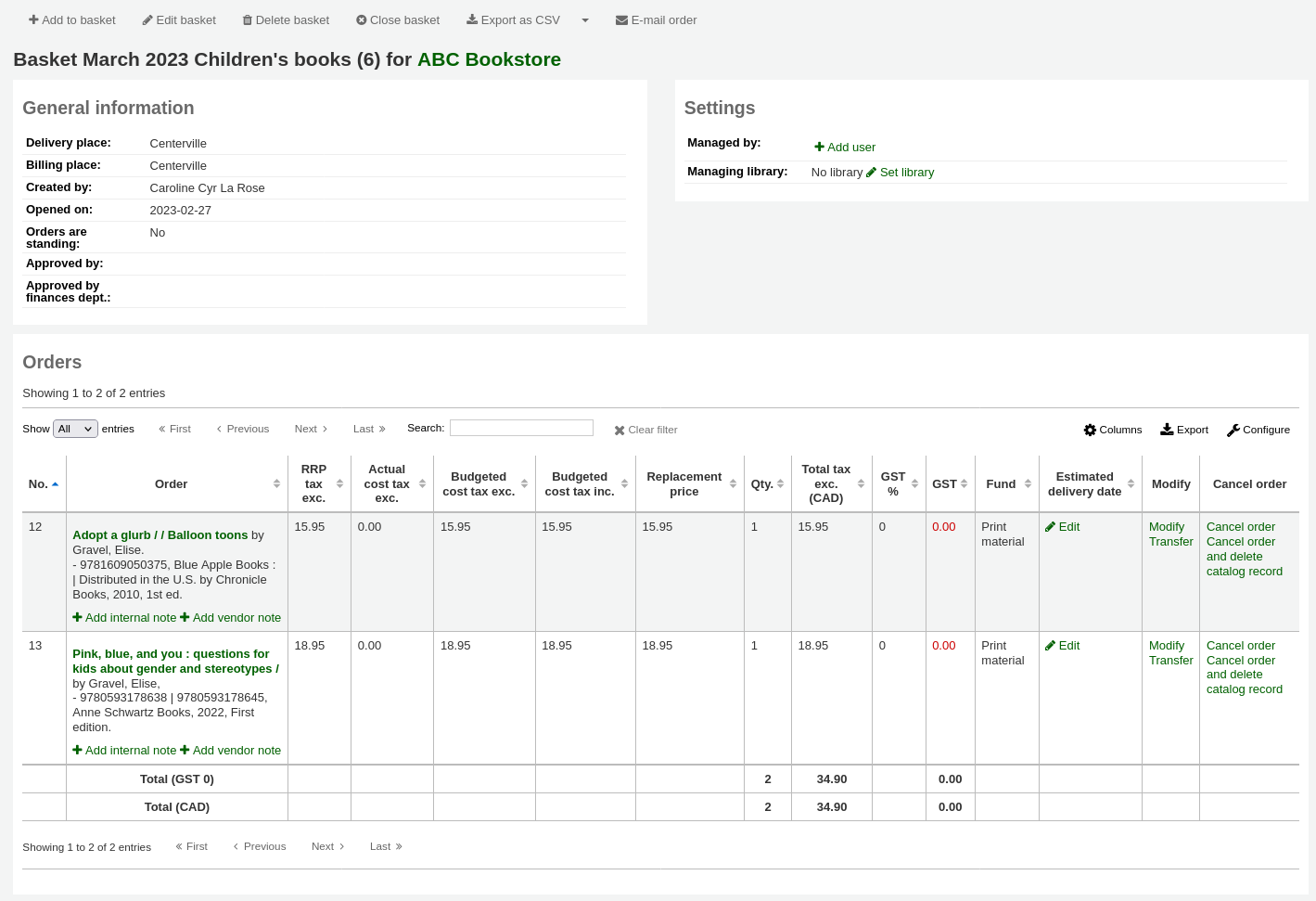
Nota
Puede personalizar las columnas de esta tabla en la sección “Configuración de columnas” del módulo de Administración (id de tabla: orders).
From the basket, you can edit or remove the items that you have added.
Choosing to “Modify” the order will take you back into the order form in case you need to modify the accounting details or the items.
Choosing to “Transfer” the order will allow you to move this order from this vendor’s basket into a different vendor’s basket.
Nota
The new vendor must have at least one open basket for you to be able to transfer the order.
Choosing to “Place Hold” will allow you to place a hold for a patron on this order.
Seleccionar “Eliminar pedido” borrará la orden de pedido pero dejará el registro en el catálogo.
Seleccionar “Eliminar pedido y registro del catálogo” remueve tanto la línea de la orden como el registro en el catálogo.
El registro catalogado no siempre puede eliminarse. Podrá ver notas explicando por que.
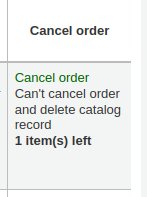
Nota
If the order was created from a suggestion, the status of the suggestion will be reset from “Ordered” back to “Accepted” if the order is cancelled.
En la página de resumen, tambien tiene las diferentes opciones mediante los botones a la cabecera de la cesta.

Add to basket: add orders to the basket
Editar cesta: editar la cesta de información, como el nombre o el lugar de cobro.
Delete basket: if the basket is empty, you will get a simple confirmation message before deleting the basket. If the basket contains orders, you will get a confirmation message with several options.
Borrar cesta y pedidos: esto borrará la cesta, cancelará los pedidos, reembolsará los fondos usados, y borrará los ejemplares (pedidos o recibidos).
Borrar cesta, pedidos, y registros: esto borrará todo lo de la parte superior más los registros bibliográficos asociados con los pedidos (excepto los que no pueden ser borrados porque tienen ejemplares restantes, pedidos o suscripciones adjuntas).
Close basket: closing the basket will enable you to add it to a basket group (this is optional) and receive its items.
Exportar como CSV: esto creará un archivo CSV con todos sus pedidos de esta cesta. Puede agregar varias opciones de pefiles CSV yendo a :ref:”herramienta de perfiles CSV<csv-profiles-label>”.
Create EDIFACT order: if you’re using EDI for your order you can click the “Create EDIFACT order” button when you’re done to send the file to the vendor and close the basket.
Pedidos por correo electrónico: esto mandará la información del pedido a su contacto para este proveedor. Asegurese de que su contacto tenga un correo electrónico en el :ref:”perfil de proveedor <vendors-label>”.
Nota
The email sent is based on the ACQORDER notice template. It can be customized in the Notices and slips tool.
Ordering (closing the basket)
Una vez que esté seguro que su cesta está completa, puede hacer clic en “Cerrar esta cesta” para indicar que esta cesta se ha completado y ha sido enviada al proveedor.

Advertencia
Debe de cerrar la canasta para poder :ref:”recibir ejemplares <receiving-order-label>” cuando lleguen. Sólo los ejemplares en canastas cerradas se mostrarán como listos para recibir.
If you have your BasketConfirmations system preference set to show a confirmation, you will be asked if you are sure about closing the basket.

When closing the basket you can choose to add the basket to a group for easy printing and retrieval. If you check the box to “Attach this basket to a new basket group with the same name” you will be brought to the group list where you can export a PDF of the order.

Advertencia
No será posible cerrar una cesta con algún ejemplar marcado como “precio incierto”.
See the section Dealing with uncertain prices below to learn how to manage uncertain prices.
Dealing with uncertain prices
Advertencia
No será posible cerrar una cesta con algún ejemplar marcado como “precio incierto”.
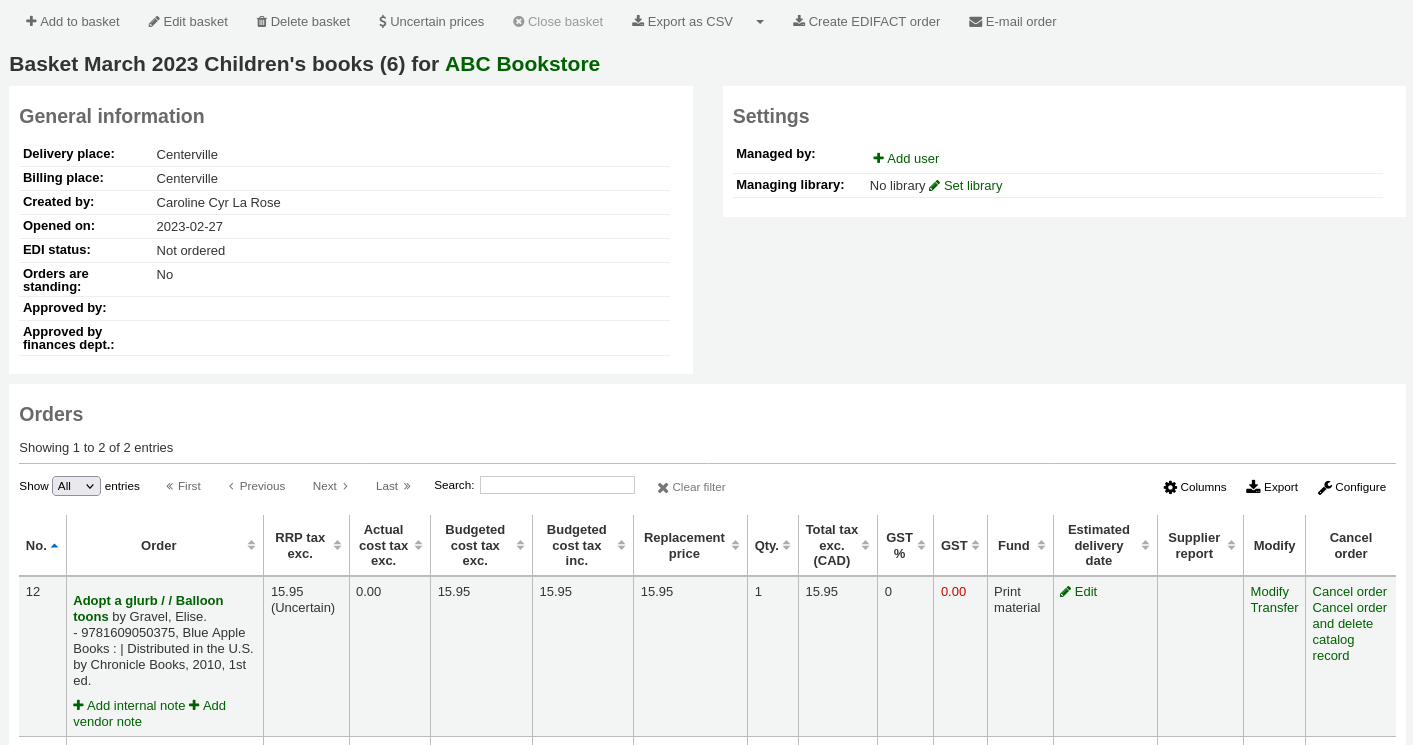
Hacer clic en el botón “Precios inciertos” le mostrará una lista de ejemplares con precios inciertos para edición rápida. De esa lista, puede rápidamente editar los ejemplares entrando los nuevos precios y cantidades.
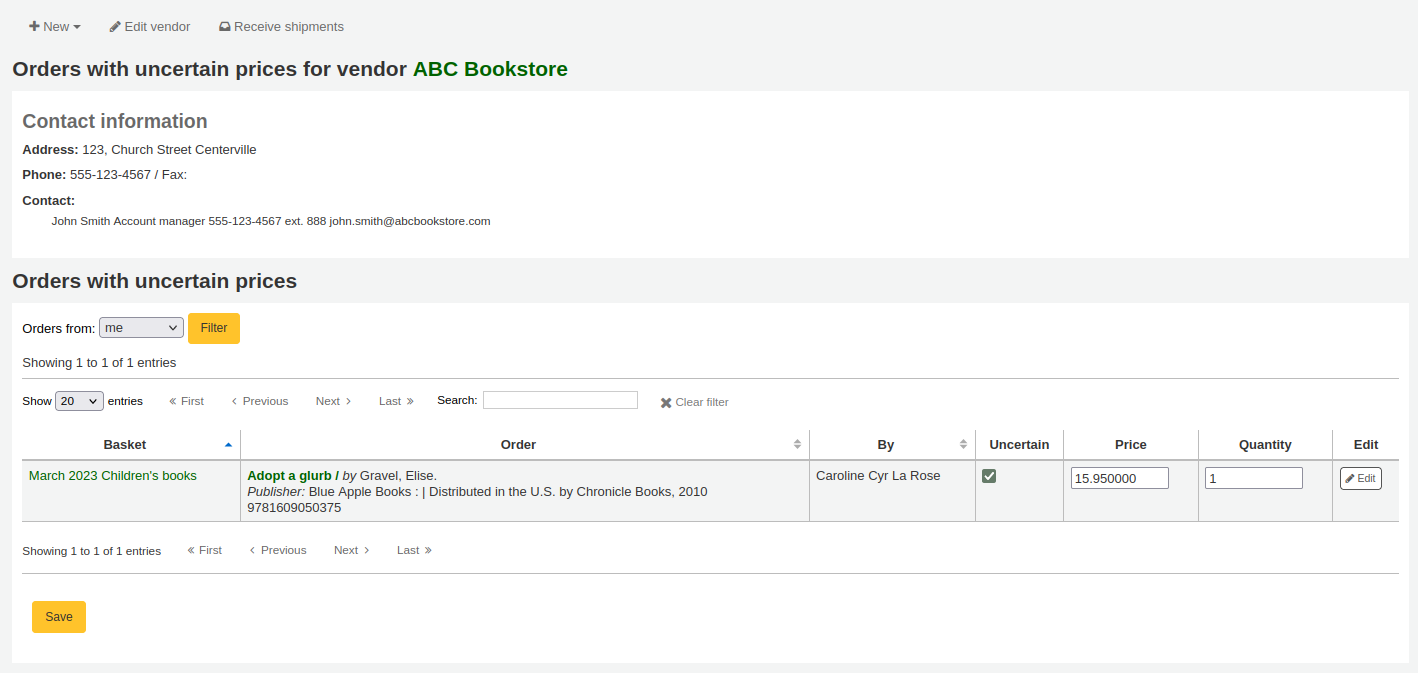
Nota
La página de Precios Inciertos es independiente de la cesta. Está vinculada con el proveedor por lo que verá todos los ejemplares en el pedido con precios inciertos para ese proveedor.
Creating a basket group
A basket group is simply a group of baskets. In some libraries, several staff members create baskets, and, at the end of a period of time, someone groups them together to send to the vendor in bulk. Note that it is possible to have one basket in a basket group, or no basket groups at all if that’s the workflow used in your library.
Nota
You cannot re-open a basket that is attached to a basket group. The re-open basket button will be grayed out.
Para crear un grupo de cestas, vaya a la pagina de detalles del proveedor y haga clic en “Basket groups” en el tabulador al lado izquierdo.


Haga clic en al botón “Grupo nuevo de cesta”.

Nombre de grupo de cesta: este es el nombre del grupo de cesta que pasará a Koha
Lugar de cobro: este es la dirección de cobro que aparecera en el pedido de grupo de cesta
Lugar de entrega: escoja una biblioteca donde los pedidos serán enviados, esto aparecera en el pedido de grupo de cesta bajo la dirección de entrega. También puede entrar una dirección diferente
Comentario de entrega: este comentario aparecerá en el pedido de grupo de cesta
Close basket group: if you know that once you’re done with this basket group, you will not be modifying it anymore, you can check this box and the group will be closed upon saving
Add baskets to the group by clicking the “Add to group” button on the right.
Para finalizar la creación de su cesta haga clic en “Guardar”.
Desde ahí, puede exportar su pedido como un archivo PDF para enviarlo a su proveedor.
Nota
The content of the PDF file is not editable, but it is possible to change its language and formatting with the OrderPdfFormat system preference.
Searching for orders
At the top of the various Acquisition pages there is a quick search box where you can perform either a Vendor search or an Order search.

Using the Orders search you can search for items that have been ordered with the title or the vendor.

You can enter info in one or both fields and you can enter any part of the title or vendor name.
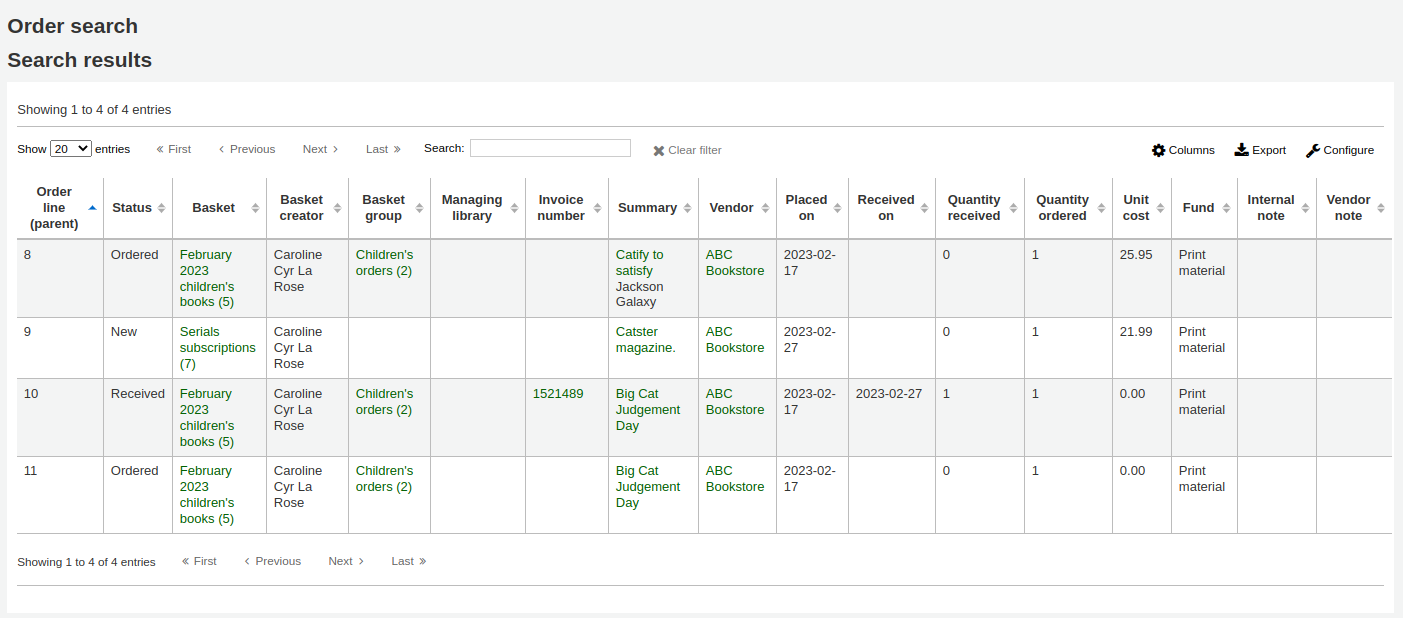
Nota
Puede personalizar las columnas de esta tabla en la sección “Configuración de columnas” del módulo de Administración (id de tabla: histsearcht).
Clicking the plus sign to the right of the vendor search box will expand the search and allow you to search for additional fields. In the basket search, you can enter any part of the basket name or its number. In the invoice number search, you can enter a part of the invoice number.

Haciendo clic en búsqueda Avanzada a la derecha del botón de búsqueda le presentará todas las opciones de búsqueda disponibles.
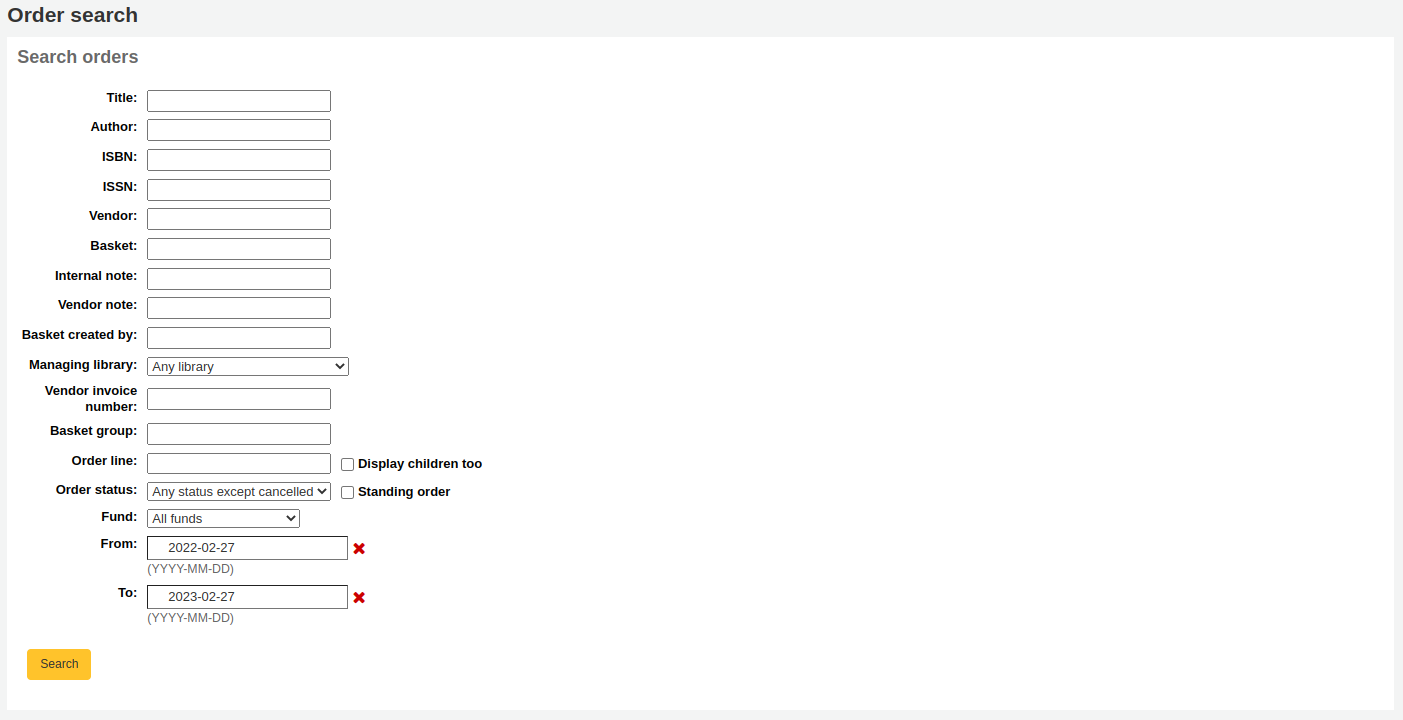
Recibiendo pedidos
Advertencia
You must close the basket to be able to receive items when they arrive. Only items in closed baskets will show as ready to receive.
Los pedidos se pueden recibir en la página de información del proveedor

o en la página de resultados de búsqueda del proveedor

After clicking “Receive shipments” you will be asked to enter a vendor invoice number, a shipment received date, a shipping cost and a fund to subtract that shipping amount from.

La página de recepción listará todos los ítems todavía en pedido con el proveedor, independientemente de que cesta es el ítem.
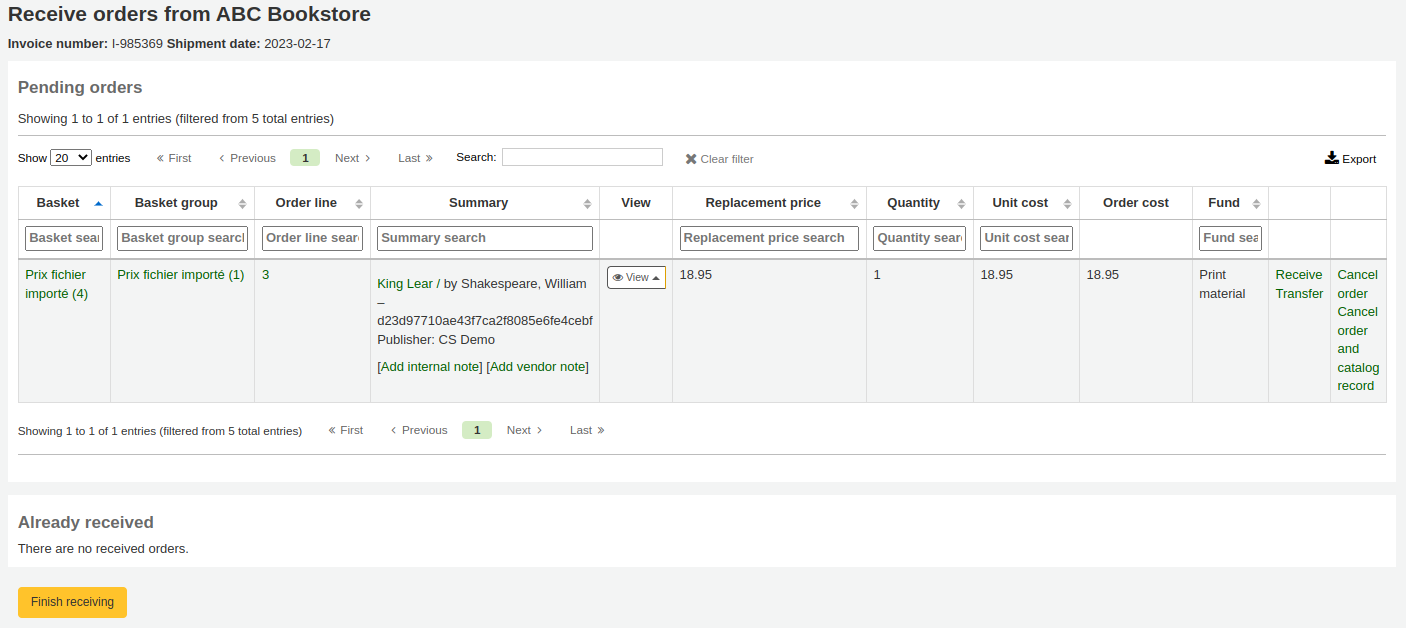
Advertencia
Only items from closed baskets will appear in the pending orders list.
Nota
If you have a lot of orders, you can filter the orders using the “Search” box just above the table, or the filter boxes at the top of each table column.

Usted puede, por ejemplo, escanear el ISBN del libro que está recibiendo en la caja de filtro y la tabla le mostrará solamente el pedido correspondiente.
Solo asegurate de despejar las cajas de filtro cuando termines, de otra manera, los otros ejemplares no aparecerán.
Para recibir un ítem específico, haga clic en el enlace “Recibir” a la derecha del ítem.
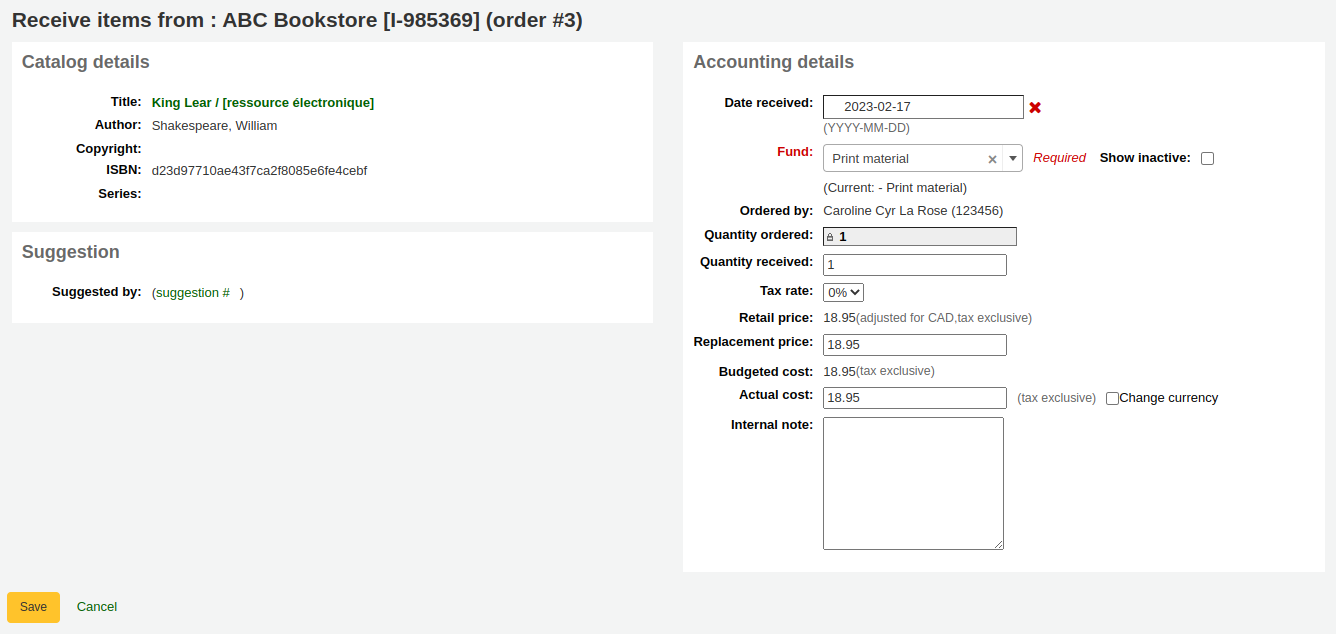
Depending on when you chose to create the item (either in the AcqCreateItem system preference, or upon creating your basket), the form will look slightly different.
Si escoge crear su ejemplar cuando ponga el pedido, tendrá la información de su ejemplar en el lado izquierdo y la información financiera en el lado derecho.
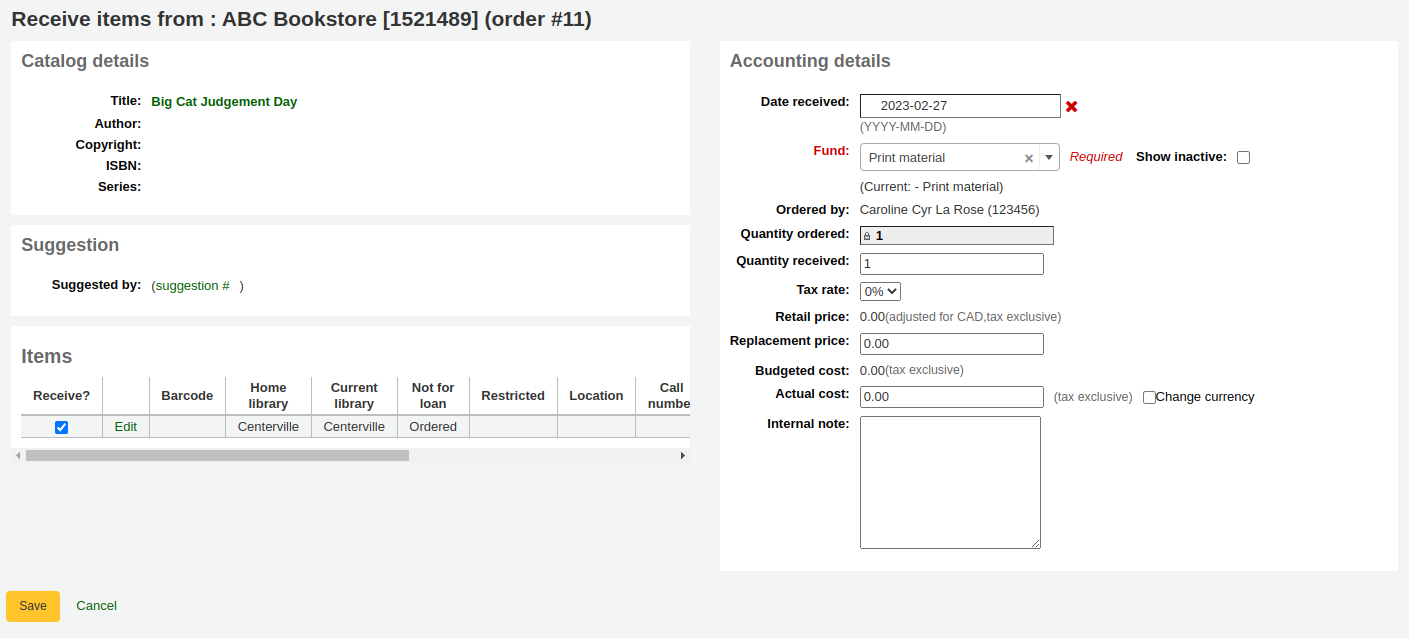
Puede comprobar la caja al lado del ejemplar que va a recibir, o llenar el campo en el lado izquierdo “Cantidad recibida”.
Nota
You can choose to mark only part of the order as received if the vendor did not send your entire order by checking only the boxes next to the items on the left that you want to receive or by entering the right amount in the “Quantity received” field.
Puede editar el ejemplar si lo necesita haciendo clic en el enlace “Editar”. Esto permite que ingrese signaturas topográficas y códigos de barra precisos si desea hacerlo al momento de recibo.
You can also alter the cost information (replacement cost, actual cost, and currency of the actual cost). The values you enter there will automatically populate the “Cost, replacement price” subfield and the “Cost, normal purchase price” subfield in the item record after saving.
Si escoge crear su ejemplar cuando reciba el pedido, usted verá el formulario de creación del ejemplar al lado izquierdo y la información financiera al lado derecho.
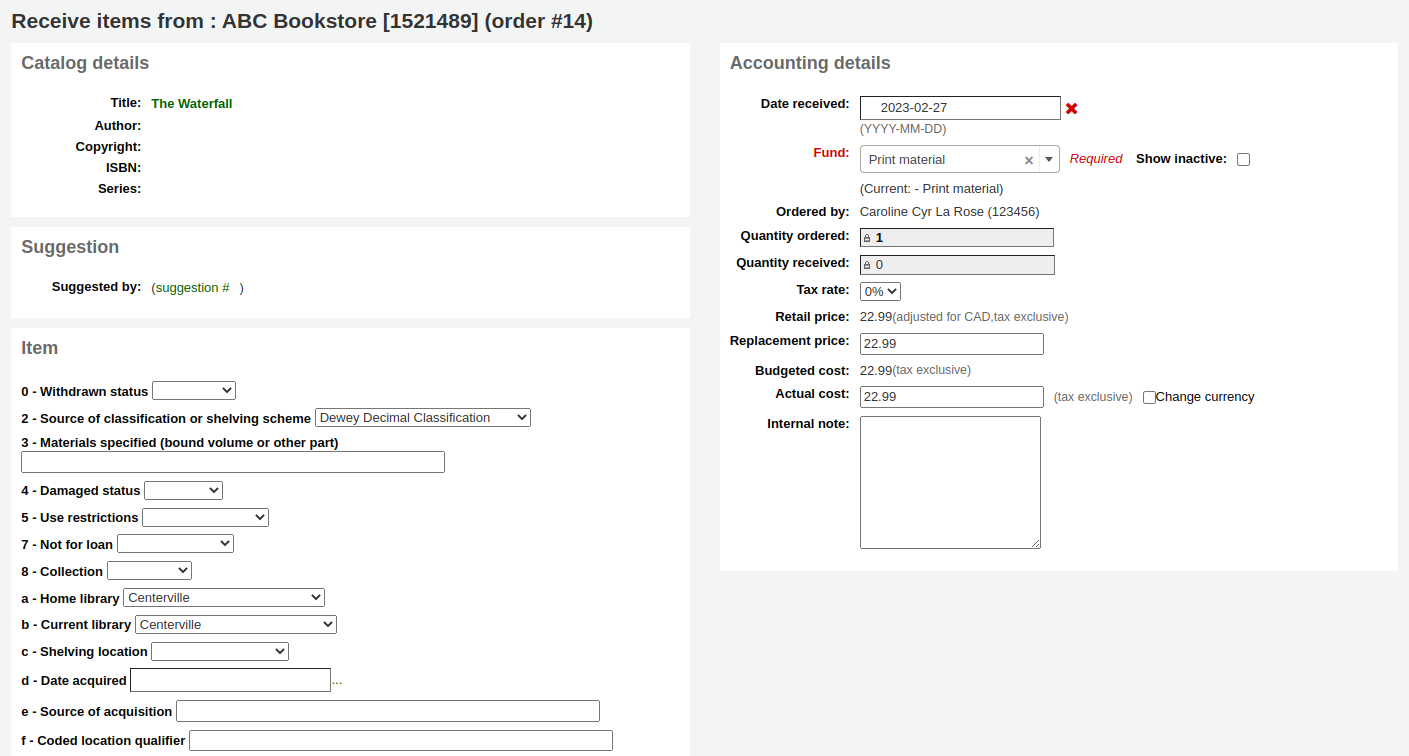
Advertencia
You must fill out the item form and click on “Add item” or “Add multiple items” in order to receive the order. You will not be able to simply change the “Quantity received” amount.
You can alter the cost information (replacement cost, actual cost, and currency of the actual cost). The values you enter there will automatically populate the “Cost, replacement price” subfield and the “Cost, normal purchase price” subfield in the item record after saving.
Finallmente, si escoge crear su ejemplar al catalogar su registro, solamente verá la información financiera al lado derecho.

You can alter the cost information (replacement cost, actual cost, and currency of the actual cost).
Nota
The financial information will not be transferred to the item if the item is created when cataloging.
Una vez que haya hecho cualquier cambio necesario ( al pedido y/o al ejemplar, haga clic en “Save” para marcar el ejemplar(es) como recibido.
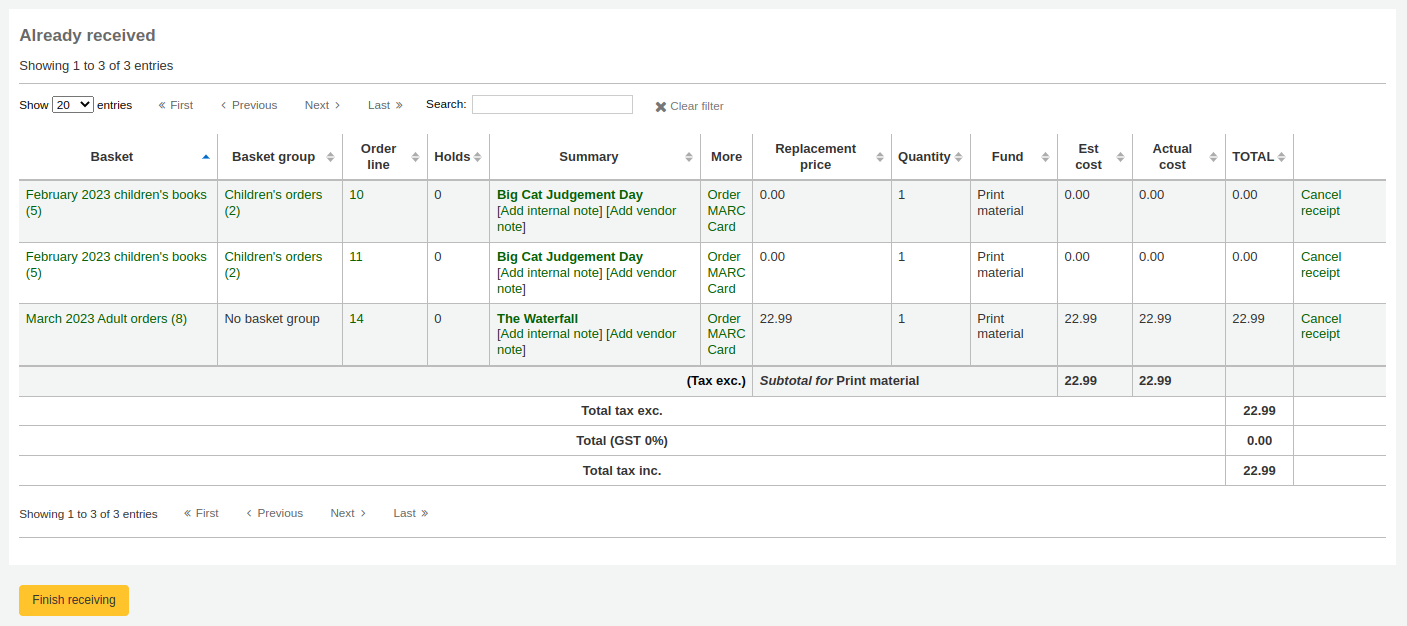
Nota
If you have your AcqItemSetSubfieldsWhenReceived system preference set to add or change values on received items those changes will take place after you hit “Save”.
Cuando haya finalizado de recibir ítems puede navegar fuera de esta página o hacer clic en el botón “Finalizar recepción” al fondo de la pantalla.
Los pedidos recibidos tendrán “(rcvd)” antes de el título en la vista de la cesta.
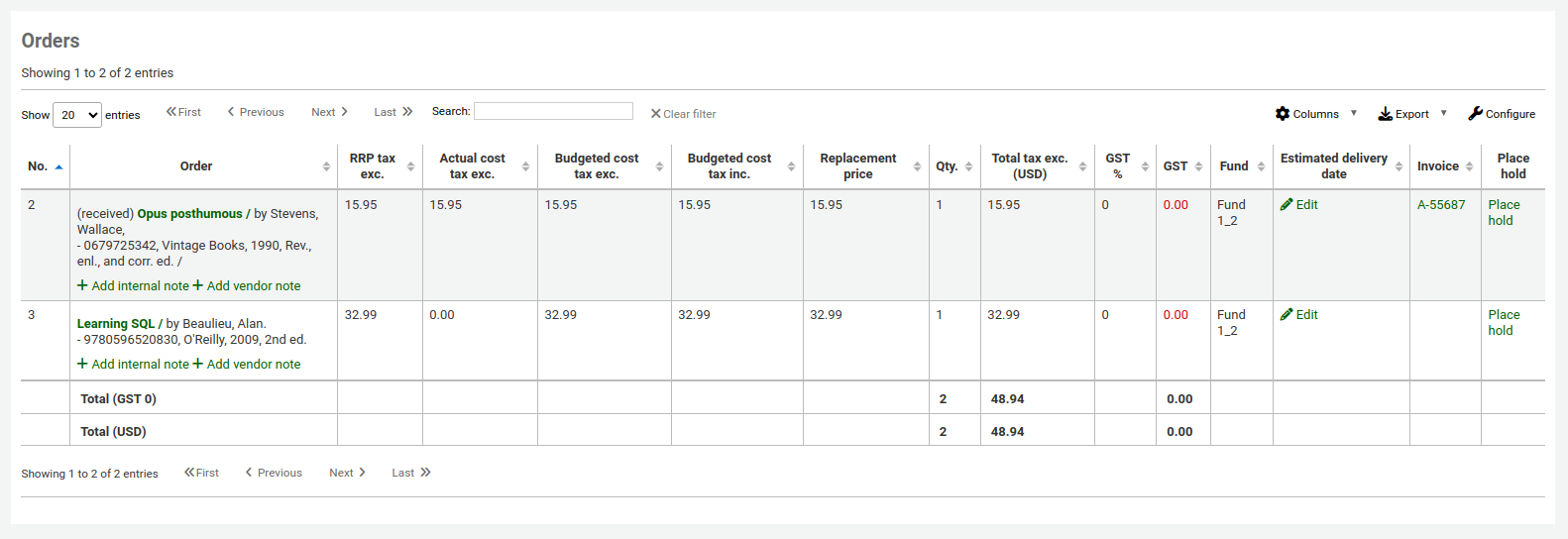
Nota
When all the orders in a basket have been received, the basket will be removed from the list of baskets for that vendor. You can click “Show all baskets” to view the inactive baskets.


Nota
If a patron was marked as needing to be notified when the order is received, they will receive the ACQ_NOTIF_ON_RECEIV notice.
If a patron suggested the purchase, they will receive the AVAILABLE notice.
Both of these notices can be customized in the Notices and slips tool.
Transferir pedidos
If the item is no longer available from this vendor you can transfer the order to another vendor’s basket by clicking the “Transfer” link to the right of the title on the basket page or the receiving page. This will pop up a vendor search box.
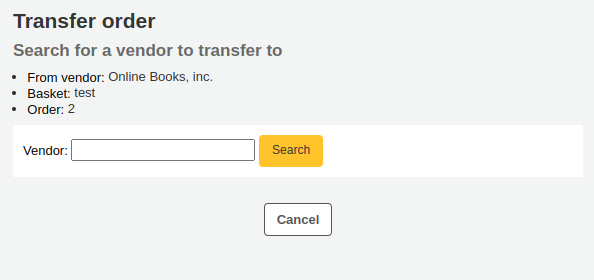
De los resultados puede elegir el enlace “Importar” a la derecha del registro que desea agregar a Koha

Se le presentara entonces con las cestas abiertas de ese vendedor para escoger. Para mover el ejemplar simplemente haga clic en “Elegir’a la derecha de la cesta a la cual le gustaria agregar el ejemplar.
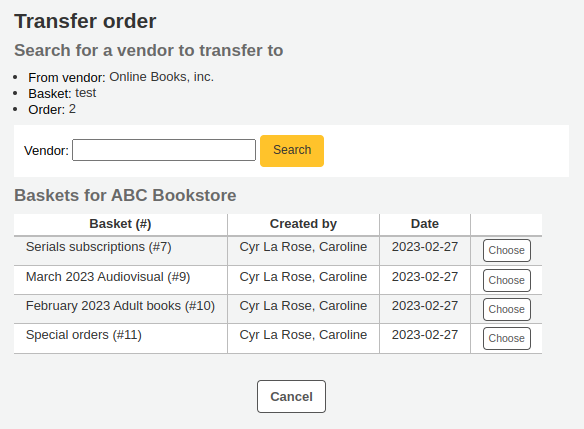
Una vez que el archivo es subido se presenta un mensaje de confirmación.
You will see transferred orders with the canceled orders when viewing the basket.
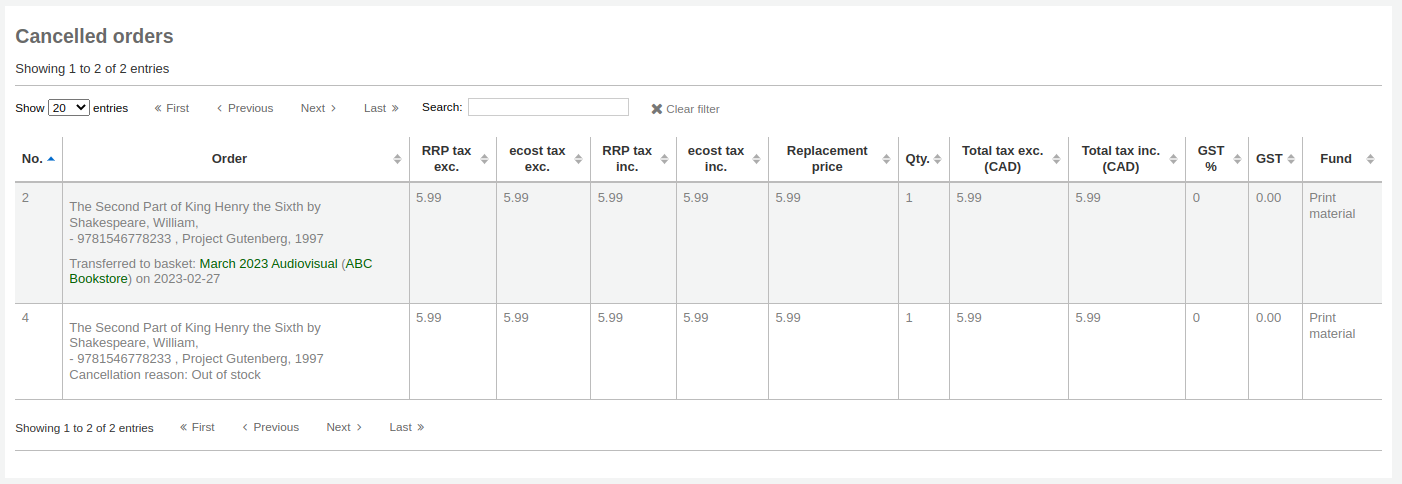
Nota
Whilst it is possible to re-open your basket (unless it is part of a basket group, in which case the basket cannot be reopened), transfer one or more orders and re-close the basket, this is not recommended. This procedure will update the “basket closed” date, which in turn will cause your “late order” calculations to be incorrect.
It is preferable to transfer an order from the receiving page.
Cancelling orders
If the item cannot be found anywhere you can cancel the order by clicking “Cancel order” or “Cancel order and delete catalog record” to the far right on the basket page or the receiving page.

This will prompt you to enter your reason and confirm cancellation.

Nota
The cancellation reasons drop-down menu are populated by the ORDER_CANCELLATION_REASON authorized values category. If there aren’t any authorized values in that category, it will be a free text field instead of a drop-down menu.
You will also see that the item is cancelled if you view the basket.

Version
As of Koha version 23.11, you can cancel orders in closed baskets by enabling the CancelOrdersInClosedBaskets system preference.
In prior versions, it is not possible to cancel orders when the basket is closed. Whilst it is possible to re-open your basket (unless it is part of a basket group, in which case the basket cannot be reopened), cancel one or more orders and re-close the basket, this is not recommended. This procedure will update the “basket closed” date, which in turn will cause your “late order” calculations to be incorrect. In those cases, it is preferable to cancel an order from the receiving page.
Facturas
When orders are received invoices are generated. Invoices can be searched by clicking on “Invoices” in the left of the Acquisitions page.
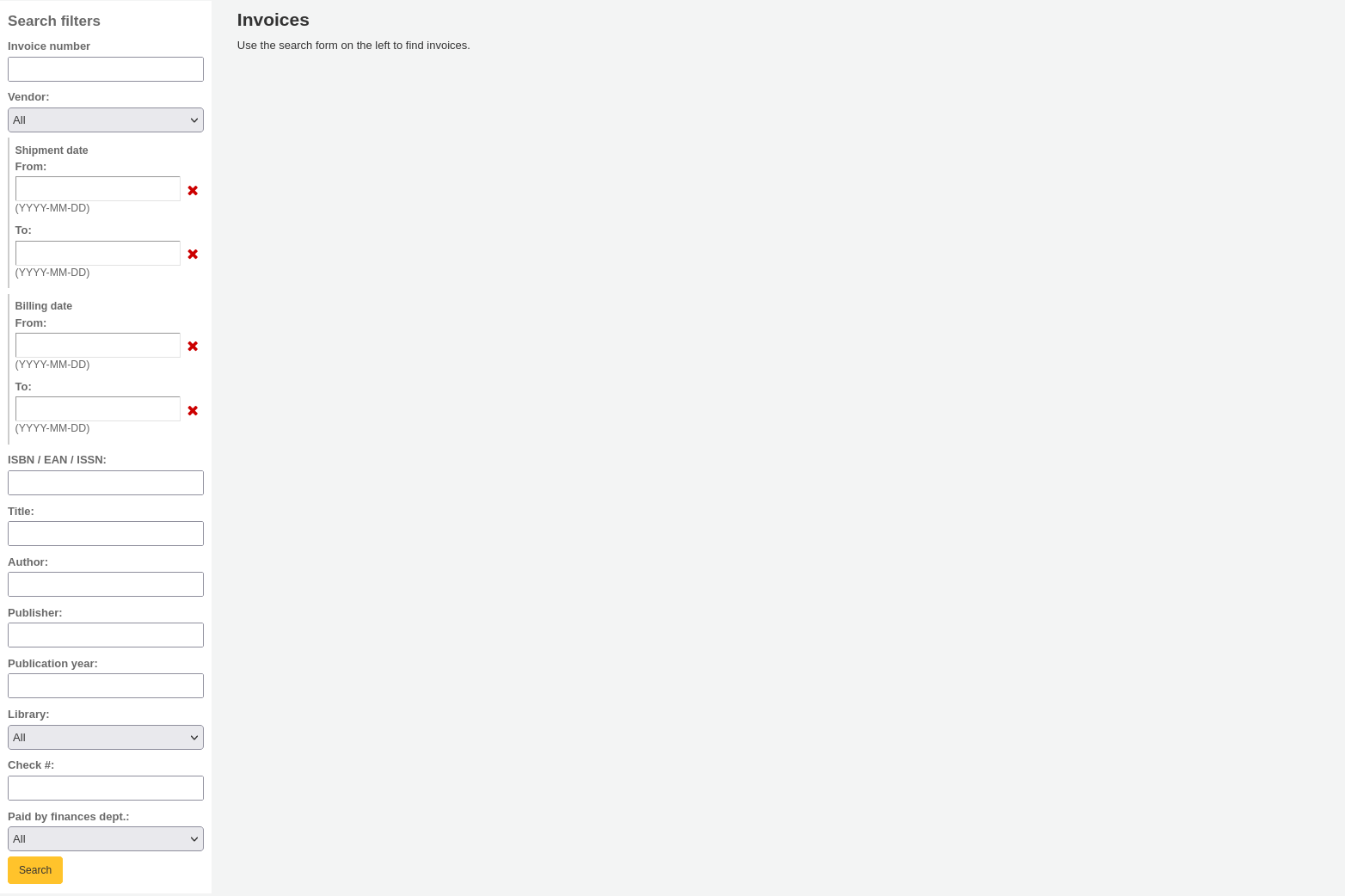
After a search, the results will appear to the right of the search options.

At the bottom of the table, there is a button to merge selected invoices and a button to close selected invoices.
The “Actions” button on the right allows various actions on a single invoice:
Details: show the full invoice
Close: close the invoice to indicate that the invoice is paid for
Delete: delete the invoice; this option is only available for invoices that have no items received on them
The detailed invoice page presents all the information about the invoice.

Invoice number: the invoice number entered upon receiving is editable here
Shipment date: date entered upon receiving is editable here
Billing date: enter the billing date of the invoice
Shipping cost: the shipping cost entered upon receiving is editable here
Shipping fund: the fund from which to subtract the shipping cost chosen upon receiving is editable here
Status: the status of the invoice, either open or closed; if closed, the closing date will also appear
Close: if the invoice is still open, it can be closed by checking this box
Reopen: if the invoice is closed, it can be reopened by checking this box
Additional fields: if there are additional fields for invoices, they will appear here.
In the Adjustments section, you can add adjustments to your invoices by clicking “Add an adjustment”.
These adjustments can be for adjusting the price that is offset by rounding or adding a credit to the invoice, for example.

Amount: enter the amount of the adjustment (can be positive or negative)
Reason: choose a reason, if needed
Nota
The reasons are populated by the ADJ_REASON authorized values category.
Note: enter a note, if needed
Fund: choose the fund from which the adjustment amount should be taken
Encumber while invoice open: if this is checked, the amount of the adjustment will be taken out of the fund immediately. If it is not checked, the amount will be subtracted only when the invoice is closed.
Click on “Update adjustments” to save your adjustments.
Si necesita cambiar el ajuste después, puede hacerlo en la tabla y haciendo clic en “Actualizar ajustes”.

In the “Invoice details” section, you will see the details of each received title in this invoice.
If needed, you can change the fund used for each title by clicking “Modify fund” in the “Fund” column.
Adjuntando archivos a facturas
If you’re allowing the uploading of acquisitions files with the AcqEnableFiles system preference you will see the option to manage invoice files next to the link to “Go to receipt page”

Para ver o adjuntar archivos nuevos haga clic en el enlace “Gestionar archivos de factura”

From here you can find a file to upload and see the files you have already attached.

Merging invoices
From the invoice search results you can also merge together two invoices or more, should you need to.

Simply click the checkbox to the left of the invoices you would like to merge and click the “Merge selected invoices” button at the bottom of the page. You will be presented with a form to confirm the merge:

Click on the row of the invoice number you would like to keep and it will be highlighted in yellow. Enter any different billing information in the fields provided and click “Merge”. The invoices will become one.
Reclamos y órdenes retrasadas
The “Late orders” link on the acquisitions main page leads to a report where all orders can be filtered to find the late orders.
Al hacer clic en el enlace de “Pedidos Atrasados” desde la página de Adquisiciones se le presentará una serie de opciones de filtro en la parte izquierda. Estos filtros se aplicarán sólo a cestas cerradas.
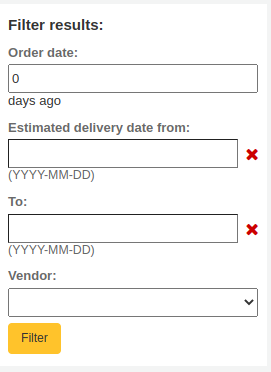
Order date: this filter limits the results to orders from baskets closed more than this number of days ago. This defaults to 0, meaning all orders from closed baskets are shown in the list.
Nota
The order date is the date the basket was closed.
Estimated delivery date from … to …: this filter limits the results to orders estimated to be delivered between two dates. The estimated delivery date is either the date entered in the “Estimated delivery date” field in the accounting details section of the order, or it is calculated as order date (date the basket was closed) + delivery time entered when creating the vendor.
Nota
The estimated delivery date can be edited in the late orders table.
Vendor: this filter limits the results to orders to a specific vendor.
Nota
The vendor drop-down menu only shows vendors with closed baskets.
Una vez que filtre sus pedidos para mostrarle lo que se considera retrasado se le presentará una lista de estos ejemplares.
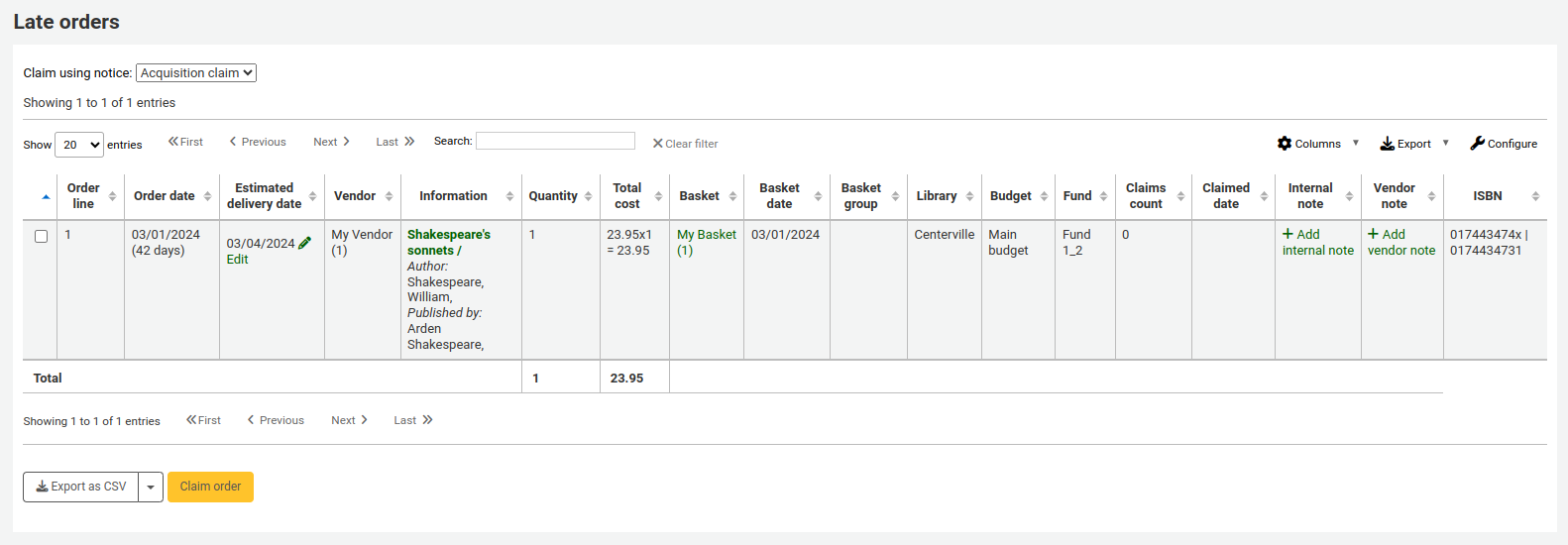
Nota
Puede personalizar las columnas de esta tabla en la sección “Configuración de columnas” del módulo de Administración (id de tabla: late_orders).
There are several options for claiming late orders.
If you have entered in an email address for a contact at the vendor’s in your system you can send them claim emails when an order is late.
Choose the notice to be sent in the “Claim using notice” drop down menu

Nota
The default notice is “Acquisition claim” (code ACQCLAIM). It can be modified in the Notices & slips tool.
You can add different notices. When creating a new notice, choose “Claim acquisition”.
Check the box to the right of the late titles to claim
Click “Claim order” at the bottom right of the list.
If the vendor does not have a contact with an email address, you can download the list of title to claim as a CSV file
Check the box to the right of the late titles to claim
Click “Export as CSV” at the bottom right of the list
Nota
The default CSV profile used is “Late orders”. You can modify it or add new ones in the CSV profiles tool.
If adding a new one, choose profile type: SQL and usage: Export late orders.
Seguimiento de Fondo/presupuesto
En la página de acquisición principal habrá una tabla mostrandole todos los fondos activos y su desglose de lo que se ha pedido o gastado en contra de ellos.

Nota
You can customize the columns of this table in the “Table settings” section of the Administration module (table id: accounts).
Nota
If the total line is confusing for the funds you have set up you can hide it by adding this code to the IntranetUserCSS preference.
#funds_total {display:none;}
The “Expand all” link will show all funds and sub-funds.
The “Collapse all” link will show only first level funds.
The “Hide inactive budgets” will hide budgets that are not currently active (such as previous years” budgets).
The “Show inactive budgets” will show budgets that are not currently active (such as previous years” budgets).
If you have several libraries in your system and have funds assigned to different libraries, you can filter the table to show only the funds for a specific library.
Para ver el historial de todas las órdenes de un fondo puede hacer clic en el importe y hará una búsqueda.
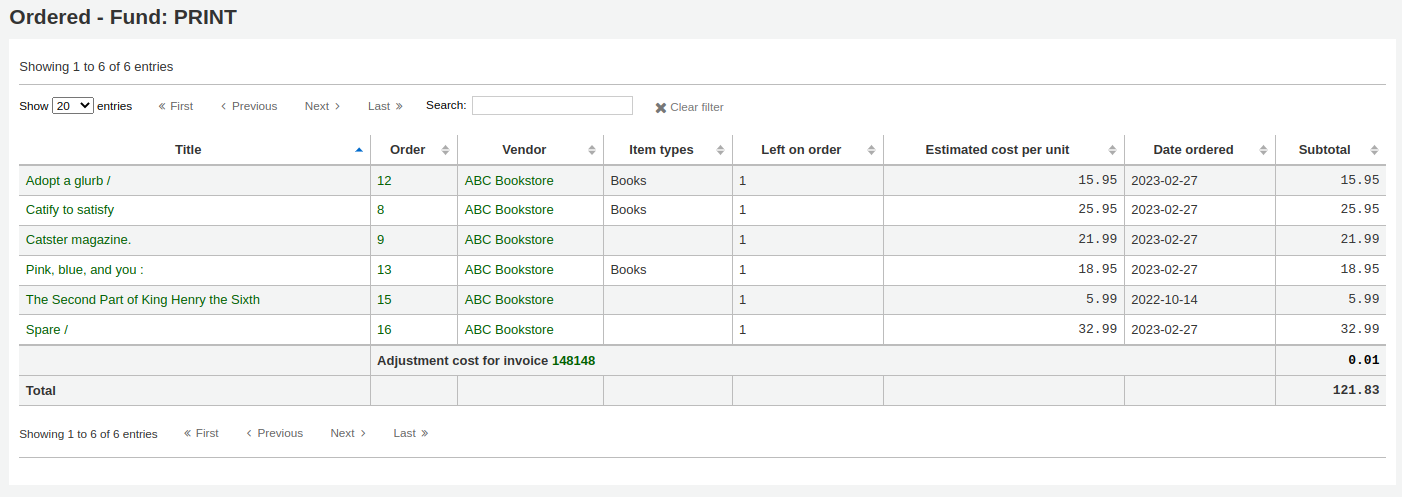
Procesado EDI
Previous sections explain all ordering options, this section pulls out the parts related to EDI or EDIFACT ordering to help those who are using EDI for some or all of the ordering process.
EDI allows order files to be sent between vendors and Koha. When the files are processed the order information is loaded directly into Koha.
The full workflow is outlined below.
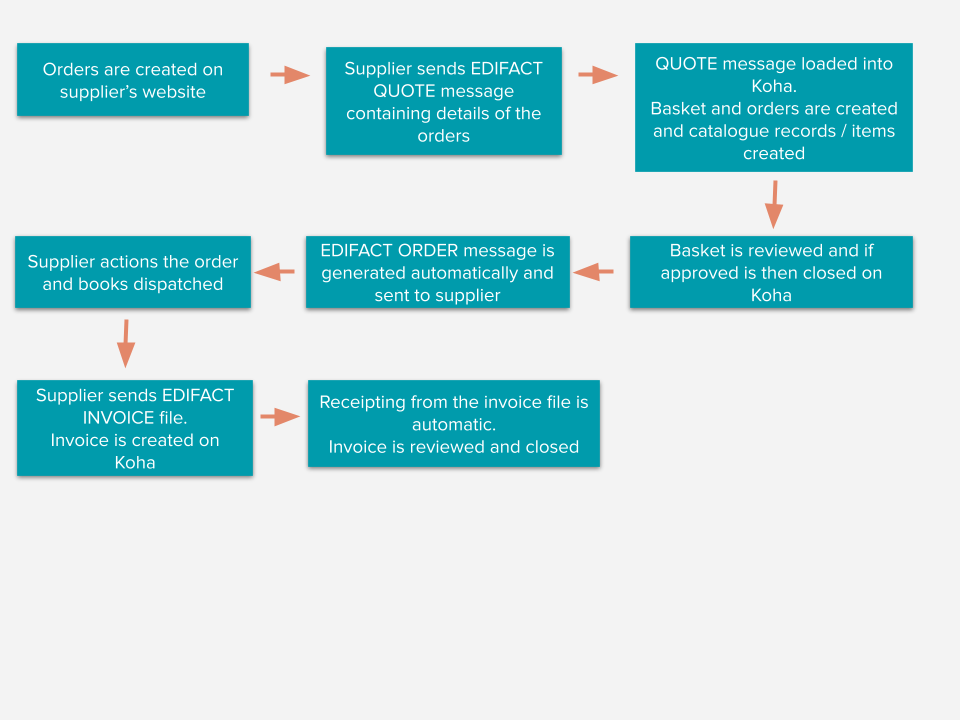
Nota
Libraries do not have to automate the full process and not all vendors support all functions. For example a library might use QUOTE and ORDER files but carry out manual invoicing/receipting. Or a library may create the basket on Koha either manually or from a file of MARC records but send the order back to the vendor via an ORDER file. Speak to your vendors to establish which functions they support.
Advertencia
Koha uses the EDIFACT standard (EDItEUR and BiC) not the X12 standard for electronic ordering.
Setting up EDI in Koha
- In order to use EDIFACT in Koha, the
EDIFACT system preference must be enabled.
Before you begin ordering using EDI you will need to take the following steps:
Ask your vendor/bookseller/jobber for their connection information. See EDI questions for vendors below.
También puede ser beneficioso solicitar al vendedor algunos archivos EDIFACT de muestra
Comparta con su vendedor/vendedor de libros/trabajador :ref:”códigos de biblioteca<libraries-label>”, :ref:”tipos de códigos de ejemplares <item-types-label>”, :ref:”códigos de fondo <funds-label>”, y cualquier otro código o :ref:”valores autorizados <authorized-values-label>” que ellos necesiten para crear su archivo de pedidos MARC
Comuníquese con su proveedor de asistencia o con la comunidad para saber si necesitará un plugin basado en las respuestas de su vendedor
Por ejemplo ByWater Solutions ha publicado plugins para vendedores especificos aqui: https://github.com/bywatersolutions/koha-plugin-edifact-enhanced
Create a vendor/bookseller/jobber record in Acquisitions
Revise sus :ref:`preferencias del sistema de Adquisiciones <acquisitions-system-preferences-label>”
Fill in the MarcFieldsToOrder system preference with values for order files (see the MARC order fields section below) if your vendor will be sending you files of MARC records for you to import manually. If the vendor will be sending automated EDI QUOTE files the MarcFieldsToOrder system preference does not need to be filled.
Enter your EDI Accounts
Enter your Library EANs
Turn on the EDI cron so that EDI files can be processed.
Preguntas EDI para los vendedores
You will need to gather the following information from your vendors before beginning the set up process in Koha.
EDI accounts
EDI accounts: This is the basic connection information for your vendor. It will be used to fill in the EDI accounts section.
Vendor: The name of the vendor
Description: A short description if additional explanation is needed (especially if you have multiple accounts for one vendor).
Transport: Does the vendor transmit EDI files via FTP, SFTP, or something else that requires special processing?
Options:
FTP
SFTP
FILE
Remote host: The URL or IP address of the FTP/SFTP server
Username: The username for the above server
Password: The password for the above server
Download directory: The path on the server that contains files for Koha to download and process
Upload directory: The path on the server that Koha will upload files to for your vendor to process
Qualifier: Who assigned the SAN below?
Options:
EAN International (14)
US SAN Agency (31B)
Assigned by supplier (91)
Assigned by buyer (92)
SAN: The identifier for the vendor
Standard: Which standard is used by the vendor, this will change how the EDI messages are interpreted
Options:
BiC
EDItEUR
Quotes enabled: (yes or no) Does this vendor support sending and receiving quotes via EDIFACT and do you want to send and receive quotes via EDIFACT?
Orders enabled: (yes or no) Does this vendor support sending and receiving orders via EDIFACT and do you want to send and receive orders via EDIFACT?
Invoices enabled: (yes or no) Does this vendor support sending and receiving invoices via EDIFACT and do you want to send and receive invoices via EDIFACT?
Responses enabled: (yes or no) Does this vendor support sending and receiving responses via EDIFACT and do you want to send and receive invoices via EDIFACT?
Automatic ordering: (yes or no) Check this box if you want quotes to automatically generate orders.
EAN
Each library using EDIFACT needs to specify a buyer identifier know as a SAN or EAN. This will fill in the Library EANs setting.
Library: Choose the library this EAN represents
Description: Add a description to this EAN, if needed
EAN: Enter the EAN
Qualifier: Choose who assigned the EAN above
Options:
EAN International (14)
US SAN Agency (31B)
Assigned by supplier (91)
Assigned by buyer (92)
MARC order fields or grid ordering
Nota
This is only necessary if your vendor will be sending you files of MARC records for you to import via the Stage MARC records for import tool. If your vendor will be sending automated EDI QUOTE files the MarcFieldsToOrder system preference does not need to be filled.
These values will fill in the MarcFieldsToOrder system preference.
price: MARC21 field that contains the item price
quantity: MARC21 field that contains the number of items for the given record
budget_code: MARC21 field that contains the Koha budget code to be debited
discount: MARC21 field the contains the discount as a percentage the the price will be discounted by
sort1: MARC21 field that will populate custom field sort1
sort2: MARC21 field that will populate custom field sort2
Ordering via EDI
The first step in ordering using EDI happens on the book vendor’s website. Each seller will use different language, but you will need to place your order on their site. Some language that you might see included «basket», «order», «cart», and/or «MARC order». The vendor will then either send you a file of MARC records to import into Koha OR the vendor will send a QUOTE file if you have this enabled in your EDI accounts settings.
Working with a MARC file
Once you have this MARC file downloaded to your computer you will want to log in to Koha and continue the process there.
In Acquisitions create a basket for the vendor you ordered from. Add your file to the basket by ordering from a new file.
From the confirmation screen you will see all of the data in the MARC file related to your order. If you are not seeing fields such as fund and quantity filled in then be sure to confirm that your MarcFieldsToOrder preference is set right.
Una vez que haya prestado todos los ítems al usuario usted puede imprimir un recibo eligiendo uno método de los dos disponibles.
Nota
The “Create EDIFACT order” button only displays is you have enabled the EDIFACT system preference.
You will be asked if you wish to create the EDI order and close the basket.
Enviando el pedido EDIFACT
This will generate an ORDER file with the status “Pending” in the EDIFACT messages in Koha.
The pending files will be processed by the EDI cron job and sent to your vendor and the status in EDIFACT messages will be updated to “Sent”.
Working with a QUOTE file
If you have QUOTE files enabled you can place the order on the bookseller’s website and a QUOTE file will be automatically generated and made available to be collected and loaded to Koha. You will see the file listed in the EDIFACT messages in Koha with a status of “Received”. The basket will have been created and records and items added to the basket.
Once you have checked that the basket is correct you can click the “Create EDIFACT order” button. The process then completes as for Sending the EDIFACT order above.
facturación EDI
When the book vendor is done processing your files they can send an INVOICE file via EDI as well. The EDI cron job will grab invoice file, create an invoice on Koha and mark items found in the invoice as received and update your funds without any need for manual intervention. As a final check the invoice can be reviewed and closed if all items have been receipted correctly.
INVOICE files can be viewed in the EDIFACT messages. Processed files have the status “Received”.
If you set the EdifactInvoiceImport preference to “Don’t” you can load invoice files manually.
Mensajes EDIFACT
Un registro de todos los mensajes enviados y recibidos vía EDIFACT pueden ser encontrados bajo mensajes EDIFACT.
